Yachting World
- Digital Edition


How to berth and anchor a yacht in the Baltic
- Rachael Sprot
- December 19, 2023
Rachael Sprot takes a look at the many skils needed to berth or anchor a yacht in the Baltic, from Y-berths to rock moorings

The Baltic offers rich and extensive cruising grounds, but much of its appeal lies in the opportunity to anchor in remote archipelagos which require a few specialised techniques to confidently tie up.
It’s worth noting that the average yacht in the Baltic is smaller than those in the UK, with 30-35ft seemingly the standard size for a family cruiser. These are often boats built in the 1970s or 1980s with a narrow beam and low freeboard, which means boat handling tends to rely on a push and shove rather than springs and pivot points. Boats over 40ft are more unusual, although they can be accommodated.
There is very little alongside berthing in the Baltic. Last time I was there, a Finnish skipper of a 36-footer berthed alongside a wall took out his seamanship manual to remind himself how to spring off against a cross wind. He did it beautifully, there was no question of his seamanship, it was just a manoeuvre which is rarely required.
There are also very few cleats: the strong points onshore tend to be rings, so you can’t rely on lassoing the dock from the boat. You either need to get a crewmember close enough to feed a line through the ring, or use a boathook with a special mooring clip on it to secure to.
Marina berthing requires nifty line handling from the crew. Berths can be approached stern-to if that’s your preference, which will certainly make leaving the next day a bit easier, in which case just reverse the procedure to set a bowline first and then attach a stern line to the dock.

Y berths are effective at separating boats but are not intended to be walked upon. Photo: Martin Leisborn
These wobbly structures look like finger berths but they aren’t designed for a person to stand on (as several British sailors have found out the hard way), they merely present a strong point for attaching to and separating the berths. It’s best to make sure you have lines and fenders rigged on both sides before coming in.
As you enter the berth a crewmember standing at the widest point of the boat needs to attach the windward sternline or midships line, depending on your preference. If double-handed, they can then give this to the helm before nipping ashore from the pulpit with the windward bowline. You then need to set up the other lines.
If the berth is very narrow fenders may need to be abandoned. Some Baltic yachts have a rubbing strake, but you can also drape a heavy line over the side to offer topsides protection.

Box berths require the skipper to squeeze the boat between two piles. Photo: Martin Leisborn
A box berth is similar to a Y berth, but instead of a floating boom between each slot there are two piles to squeeze between.
Again, the key is to secure the windward sternline from midships as you glide past, perhaps with a big bowline lassoed over the top of the post, or a line passed around it. This way it can be pre-rigged for the helmsperson to pull in the slack. Once again the crew then needs to step off with a windward bow line.
In this case fenders can be quite a hindrance as they can get hung up on the posts. Some people prefer to have them lying on the side decks, ready to kick off once you’re through the gap, or rig them horizontally with a sail tie holding the bottom end up.

Stern buoys are often found in busy harbours and can be some way off the dock. Photo: Martin Leisborn
Stern buoys are a more minimalist approach to berthing and often found in busy harbours. They consist simply of a tall mooring buoy some way off the pontoon. Again, a stern line needs to be attached on the way past, but bear in mind that stern buoys can be 20m or more from the dock, so it needs to be a long line which can be paid out. For ease of departure the next day it helps to set this line to slip, in which case it may need to be very long and requires careful management to ensure that whatever slack is paid out doesn’t end up around the prop.
Many local boats have a long metal hook to which they tie their mooring line, hook the buoy as they go past and then let go, the hook kept in place by gravity and line tension.
There’s usually only one stern buoy. It can be left to windward or leeward on approach and this will often depend on how the other yachts are lying. Securing it on the leeward side of the boat will help keep the yacht square to the dock in a cross wind.
Have your fenders deployed as it’s likely you’ll lie on the yacht next door until you’ve got the fore and aft lines tensioned.

Rock moorings are not for the faint-hearted and require careful inspection for possible underwater protrusions. Photo: Chris Beeson/YM
Rock moorings
The only thing cooler than sailing through the lunar landscape of the Baltic archipelagos is tying up to a rock when you stop. Rock mooring can be done in two ways: bows-to with a kedge anchor or, for the very brave, alongside. Local knowledge, a decent pilot guide or reconnaissance by dinghy is required to identify suitable spots.
If approaching bows to, then the kedge needs to be deployed 2-3 boat lengths out. The helm can pay out the warp while the bow team focus on getting a line ashore. In some places there are mooring eyes in the rocks, but a tree or sturdy boulder also work. Snug up the kedge line to hold the bow off the rocks and drop back to give more clearance overnight.
Check the forecast for wind shifts – you need settled conditions or an offshore wind. You don’t want to end up beam on to a strong wind, as you’ll be entirely reliant on the kedge holding.
Many boats that cruise the Baltic have open pulpits or fold-down bow ladders to make stepping down onto the rock easier. Alternatively, a board lashed in place can make a useful step.
Mooring alongside a rock is not for the faint-hearted. You need to be certain that the rock face is clean with no underwater protrusions. You’ll also need to identify strong points to attach lines to before coming alongside. Some people use climbers’ crevice hooks, but these damage the rocks and should be avoided if possible. A couple of slim tyres are better than fenders as they’ll sink below the waterline. Start off mooring alongside for lunch stops only, and anchor off for a good night’s sleep.
If you enjoyed this….
Yachting World is the world’s leading magazine for bluewater cruisers and offshore sailors. Every month we have inspirational adventures and practical features to help you realise your sailing dreams. Build your knowledge with a subscription delivered to your door. See our latest offers and save at least 30% off the cover price.

- August 6, 2020
Professional Tips For Berthing At the Marina
Berthing at the marina can be a challenging experience even for those experienced in boating. To help you master berthing your vessel, we have put together a quick guide providing steps for a proper berth. We have also added some useful tips to help you berth in any condition you may find.
Steps For Berthing
Here is a simple 8 step process for berthing successfully.
- Determine the type of wharf for your berth; pontoon or fixed.
- Find the easiest side of the pontoon or wharf to berth on and determine your best approach angle.
- Prepare the fenders at a height and position on the vessel appropriate to the wharf or pontoon you are approaching.
- Prepare any ropes needed to secure the vessel after it’s berthed. You’ll need a stern line and a bow line to secure the boat to the wharf. You’ll also need at least one springer line to prevent fore and aft movement.
- Slowly approach the wharf in a straight line on your ideal angle.
- Rotate the vessel at the proper moment to have it moving slowly in parallel with the wharf.
- Slow the vessel and bring it to a stop alongside the wharf or pontoon.
- Using the stern line, secure your vessel to the wharf.
There are some important points to remember when berthing:
- Berthing your vessel is best done at idle revs.
- Berthing is easier if the wind is blowing you towards the wharf or pontoon; ideally, wind at your stern.
Professional Berthing Tips
Berthing your boat is simple in theory but much more difficult in practice. You could be an excellent sailor and still struggle with marina berthing.
Here are our best tips to help you master your berthing.
1. Know Where You’re Going
When you visit a marina for the first time, the arrangement of the pontoons and the berth numbering system are often not clear. It’s helpful to look in advance to see if this information is available in charts of the area or in a pilot book. With this information, you’ll know exactly where you’re going and are less likely to face a challenging situation.
2. Determine What The Wind Is Doing
Apart from the tide, the wind is the most important factor influencing boat handling. It is the biggest factor in marinas in non-tidal areas, locked basins, and some dock basins. It’s important to remember that wind gusts have a larger effect when moving at slow speeds or maneuvering in a confined space.
3. Mind The Tide
In a marina in a river or estuary, the tidal stream will likely be the biggest influencer of boat handling. It’s important to know the direction the tide is flowing before entering a confined space. Be aware of its strength, both in the outer part of the marina near the faster streams and the inner pontoons where the streams are weaker.
If you need to turn around in this kind of marina, turn in the direction that will keep the bow pointing into the stream. This allows you to stem the tide mid-turn, effectively increasing the room you have available. In contrast, if you attempt to turn the bow downstream you’ll likely run out of space quickly.
4. Be Extra Careful Of Cross Tides
Most marinas are designed so tidal streams are parallel to the pontoons you moor alongside. However, sometimes this is not the case when a marina is located near the bend of a river. In this situation, the stream can create a considerable angle to the berths. Furthermore, the angles of cross tides can vary during different stages of the tidal cycle.
5. Use Mid-Ships Spring
This likely won’t be necessary if you have a large crew full of people who are experienced and know exactly what they’re doing. But, if you’re sailing short-handed, using a midships spring is a useful tool.
A short spring led from a midships cleat will help secure your boat in its berth. Additionally, when leaving a berth, this spring enables you to cast off all other lines first. This leaves just the spring which can be easily slipped if necessary.
6. Use Fenders If You Need To
When berthing errors do arise, fenders provide a necessary shield between your boat, the dock, and other vessels. Fenders won’t improve the handling of your boat but can help alleviate some of the concerns stemming from an accident. This will help you focus more on maneuvering and lead to more successful berths.
7. Identify A Bail-Out Point
It’s helpful to identify in advance the point where you must fully commit to a maneuver. Doing so lets you know the last point that you can bail out if things aren’t going to plan. This will allow you to look at a potentially difficult berth while keeping a safe exit option open.
Berthing In Windy Conditions
Windy conditions have a considerable impact on the handling of your boat.
Berthing with the wind can be easier. You can slow your approach to the berth by reversing your engine’s power, head bow in, tie off and use that line to pivot in.
Berthing when the wind is blowing away from the wharf is much more difficult. To start, you’ll want to be 90 degrees to the wharf on your initial approach. Doing so will minimize the turning effects of the wind.
The maneuver requires you to use quick and aggressive use of steering and throttle. You want to use the momentum of the boat to your advantage. Run your boat towards the wharf and give the throttle a firm but controlled surge of power as you make the final turn.
When performed correctly, the boat will slide into its berth using this rotary motion, coming to a stop at the perfect spot.
Premium Harbor Locations
Let’s get you on the water in Sydney. Corleone Marinas has four beautiful marina locations across Sydney including Balmain, Drummoyne, Elizabeth Bay, and Long Island. We offer a full range of marina services including wet berths, moorings, and slipways for boats up to 60 feet.
All berths include power and water and our friendly dockmasters are on hand to assist with arrival and departures seven days a week.
Contact us today to learn more about all we have to offer.
Latest Posts

The Ultimate Guide to NSW Boating Rules
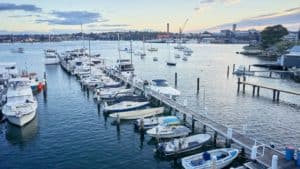
Everything You Need to Know About Mooring Fees
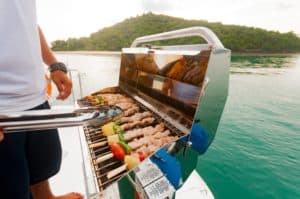
Barbecue On A Boat? Yes, It Can Be Done
Our marinas, elizabeth bay, long island, don’t stop here, more to explore.
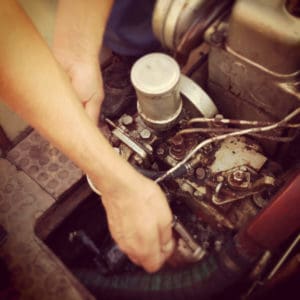
My Boat Engine Won’t Start, What’s The Problem?
Whether you’re out for an afternoon of leisure with family in the marina, or you’re in the great open ocean and ready to head back after a long day, no one wants to turn the ignition key to be met with nothing but a churning noise, or even worse, nothing at all! Here are some
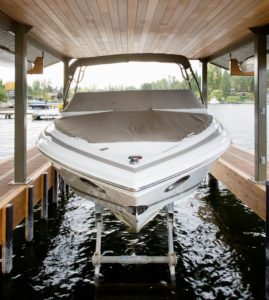
What Exactly Is Deadrise And How Does It Affect My Boat?
In general, most boat hulls are constructed in a V-shape. These angled hulls allow the ship to drop below the surface and cut through water and waves at speed. The sharper the angle, the more a ship can slice through the water and keep the ride buttery smooth. The general idea is that Deadrise is

Boat Propellor Maintenance, What you Need to Know
Whether you have a motor yacht or a sailing yacht, you probably have an engine that drives a propellor. You know that your boat and boat engine need regular maintenance, still, many yacht owners and even yacht charterers are unaware of how and why to maintain a propellor. Whether you have an inboard diesel engine
LET'S GET YOU OUT ON THE WATER
Sydney's premium harbour locations.

Corleone Marne Services Acknowledges Aboriginal And Torres Strait Islander Peoples As The Traditional Custodians Of The Land, Rivers And Sea. We Acknowledge And Pay Our Respects To The Elders Past, Present
All of our marinas are a safe spaces free of discrimination or fear; a space, free of bullying and harassment of any kind. we will work together honouring our differences and celebrating our strengths, individual qualities and contributions; upholding the values of trust, respect and confidentiality..
CMS Is Dedicated To Providing A Harassment-Free Environment For All Employees, Regardless Of Gender, Gender Identity And Expression, Sexual Orientation, Intersex Status, Disability, Ethnicity, Or Religion. We Do Not Tolerate Bullying And Harassment In Any Form. We Are Committed To Building A Diverse And Inclusive Workplace. We Pledge To Cultivate A Workplace Culture That Is Safe, Accessible, Fosters Inclusiveness, Promotes Diversity And Celebrates The Unique Skills And Qualities Of All Our Employees.
At Corleone Marinas, We Recognize Our Responsibility To Help Protect The Planet. We Are Committed To Minimizing Our Impact On The Environment And Supporting Those Who Are Working To Improve Global Environmental Sustainability. W-E’re Committed To Reducing The Impact Our Company Has On The Environment. We Care About Sustainability, And Are Continually Working To Improve Our Environmental Performance Through The Introduction And Advancement Of Policies, Procedures, And Work Practices That Allow Us To Deliver A Brilliant Service With Limited Environmental Impact. Introduction And Advancement Of Policies, Procedures, And Work Practices That Allow Us To Deliver A Brilliant Service With Limited Environmental Impact.

© 2024 Corleone Marinas. All Rights Reserved. Site by Creative Clarity
Home Boating Life How To Berth A Boat – 10 Handy Hints
How To Berth A Boat – 10 Handy Hints
Even those experienced in boating can find the prospect of berthing a cruiser, no matter the size, a little daunting. The type and size of berth, variable wind and tidal conditions will all have an impact on your ability to safely berth. You Tube is full of berthing disasters and to ensure that you don’t suffer any drama or feel the need to cover your boat in hundreds of fenders to protect it, the team at Pacific Boating has put together a simple step by step guide to make the process a little easier.
Check out our 10 step guide to Berthing and watch our more detailed training video below
Step 1: Berthing the vessel is best done at idle revs.
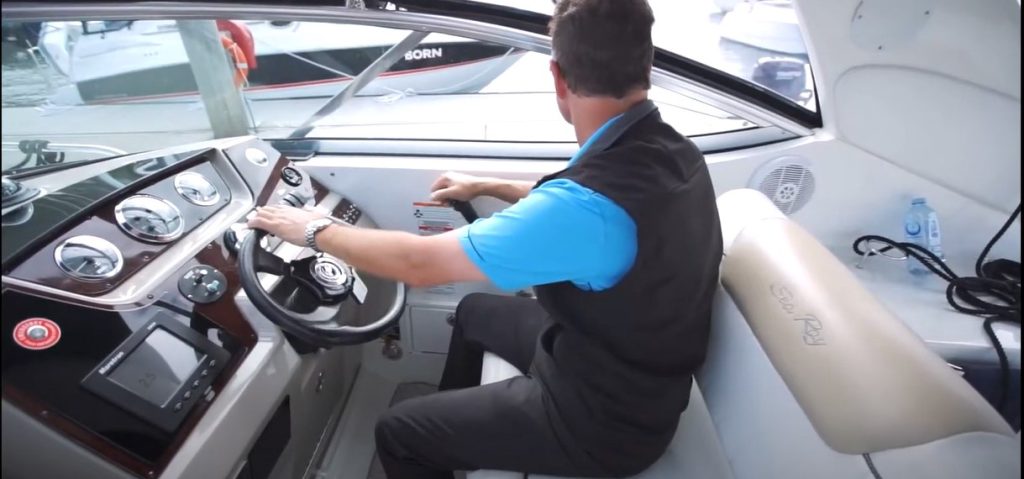
Step 2: Ascertain what type of wharf you are berthing at, pontoon or fixed.
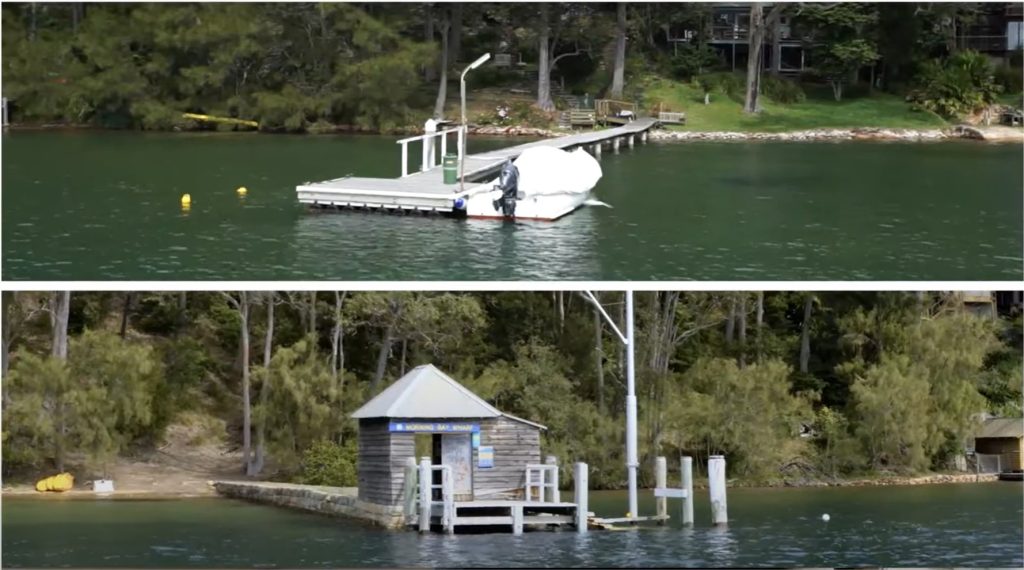
Step 3: Determine the easiest side of the pontoon or wharf to berth on and your best approach angle.
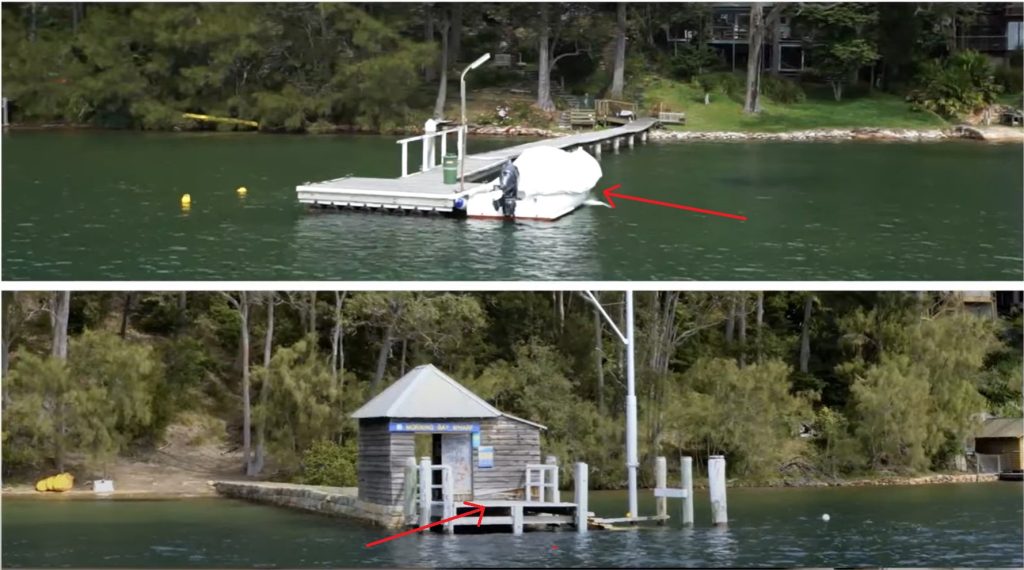
Step 4: Berthing is easier if the wind is blowing you towards the pontoon or wharf , preferably wind at your stern.
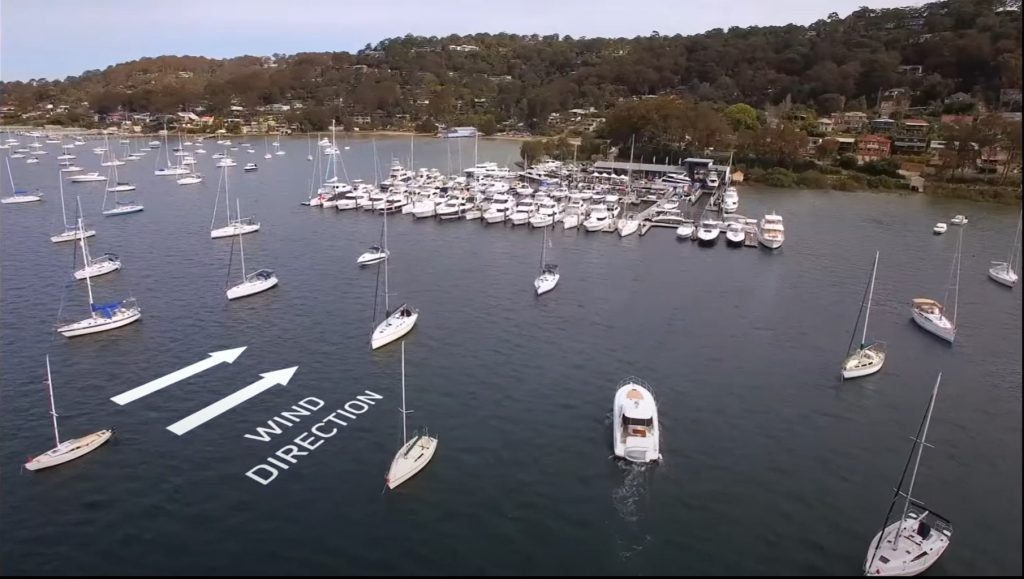
Step 5: Prepare the fenders at a height and in a position on the boat suitable to the wharf or pontoon you are approaching.
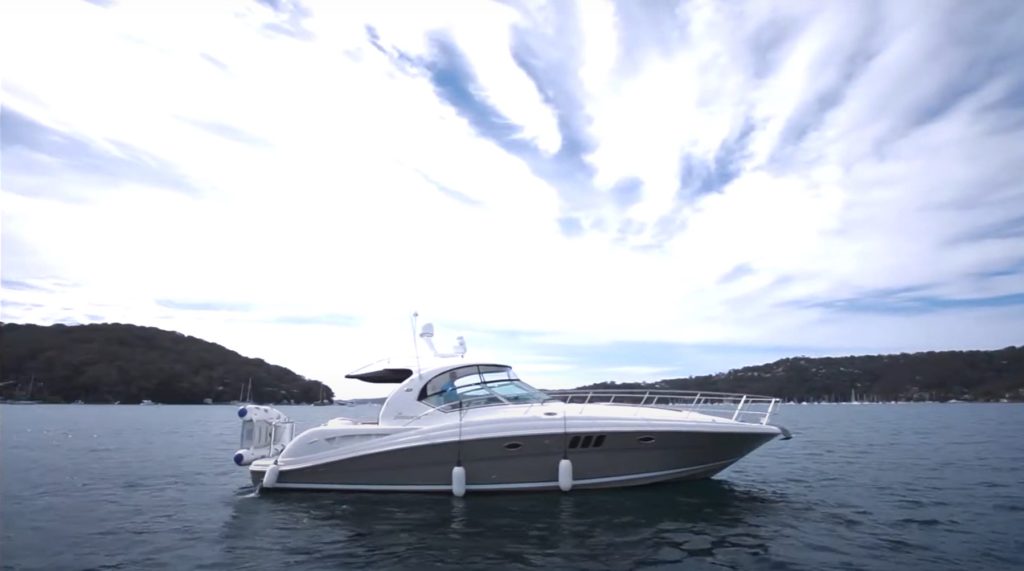
Step 6: Prepare any ropes you may need to secure the vessel once berthed. You will require a stern line and a bow line to secure the boat to the wharf and at least one springer line to prevent fore and aft movement and to keep the boat parallel to the wharf.
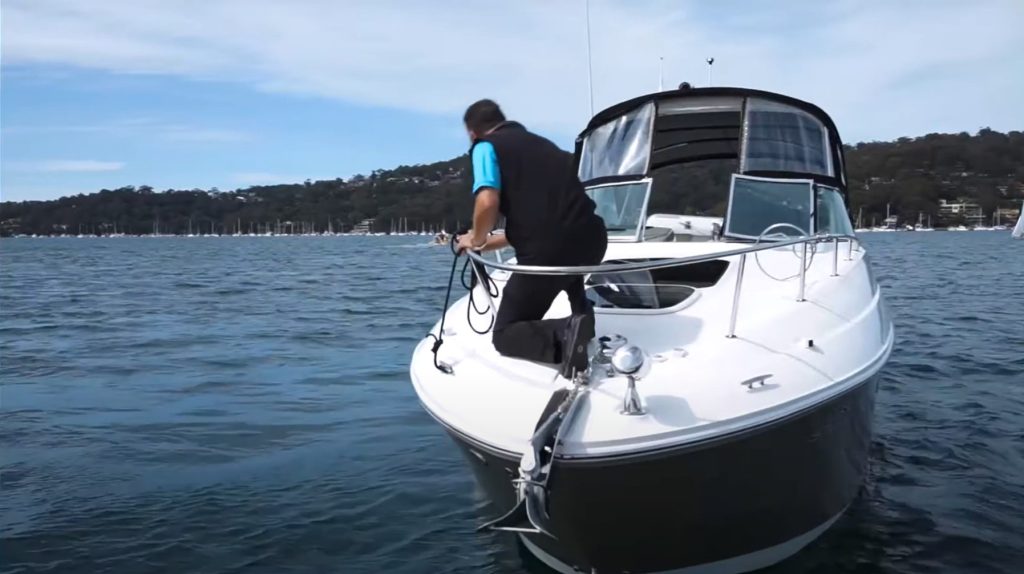
Step 7: Approach the wharf in a straight line on your ideal angle – VERY SLOWLY.
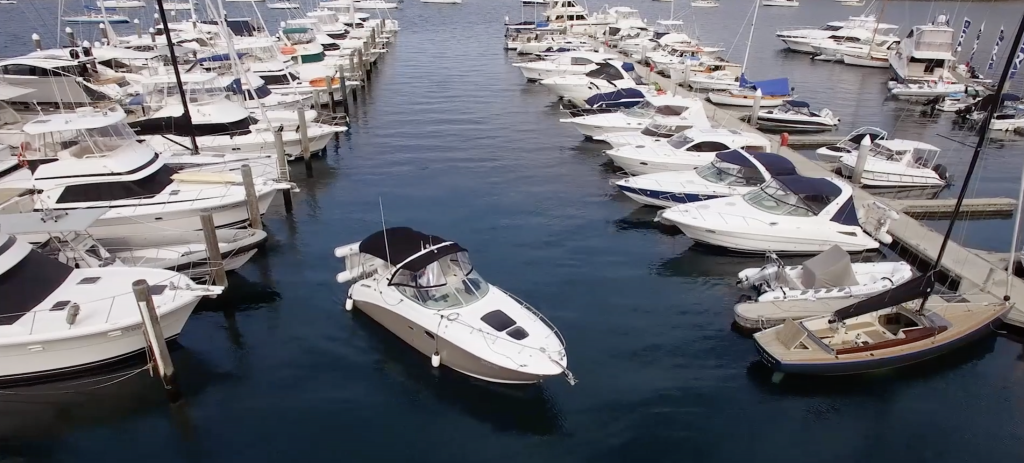
Step 8: Rotate the vessel at an appropriate moment to get the vessel sliding slowly in parallel with the wharf.
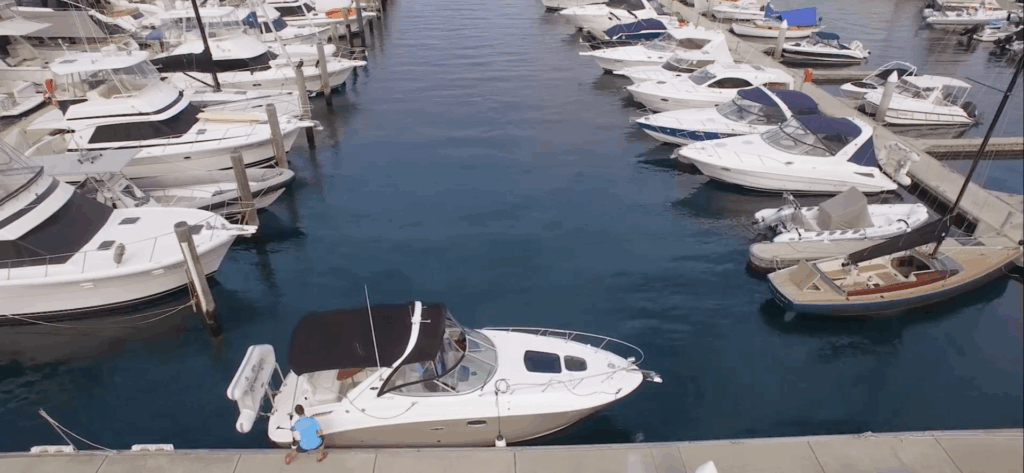
Step 9: Slow the vessel to a stop alongside the wharf or pontoon.
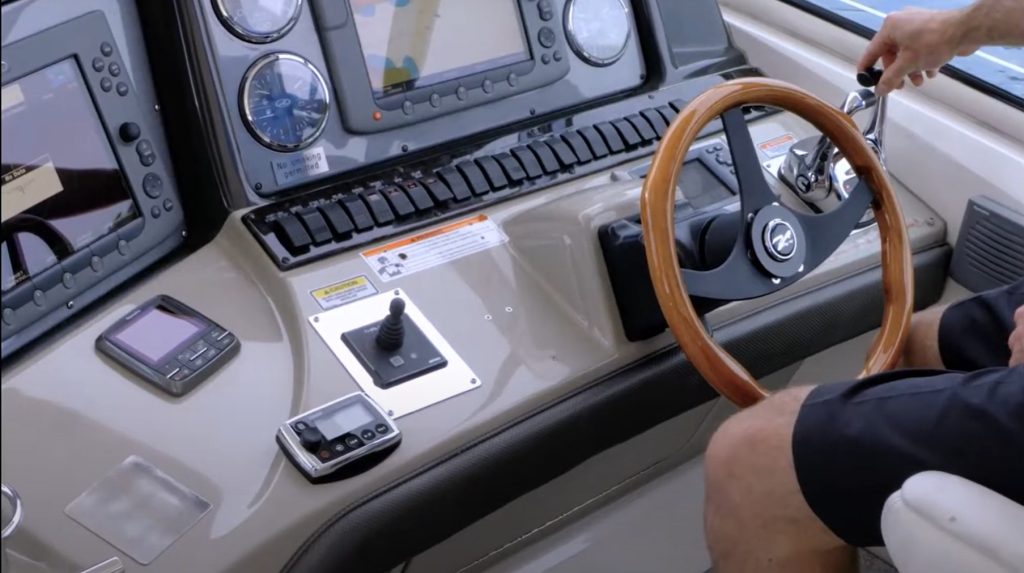
Step 10: Secure your vessel to the wharf or pontoon , stern line first ,then bow and springs as necessary.
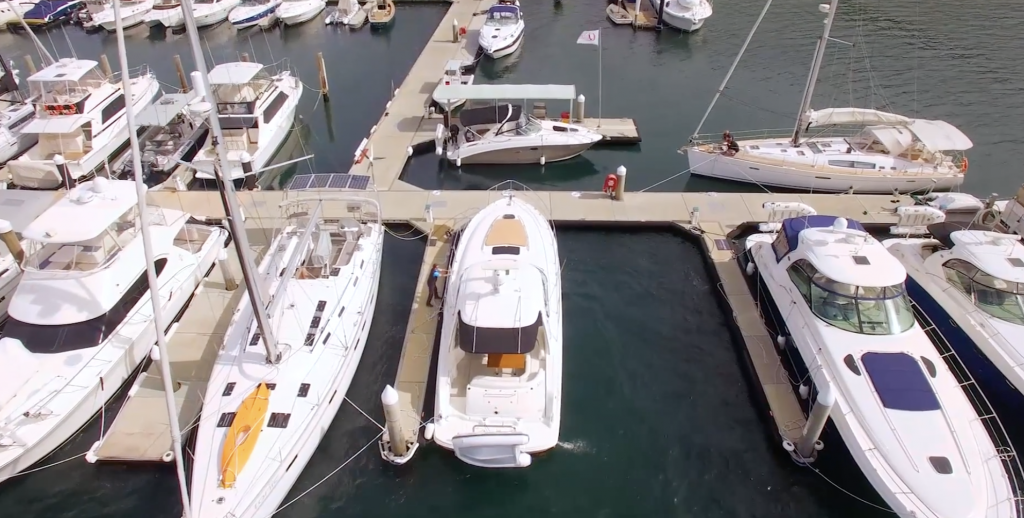
If you prefer to watch the full video on berthing, check out the video below to learn how to berth.
Happy Boating!
ENJOY THE FREEDOM OF CRUISING WITHOUT THE STRESS OF OWNING A BOAT.
Continue reading, let pacific boating get you into boating.
It all sounds great right? Join the club, explore Sydney’s stunning waterways on a luxurious sports cruiser without any of the hassles of…
How To Anchor
Let’s be honest, you cannot beat a Sydney Summer. Blue skies, balmy nights and a coast line that is begging to be explored. If…
Why Buy a Boat? Enjoy Ours…
- Walk on, walk off
- Maintenance free
- Pittwater & Sydney Harbour access
- A fleet of 18 luxury sports cruisers
- Full training provided
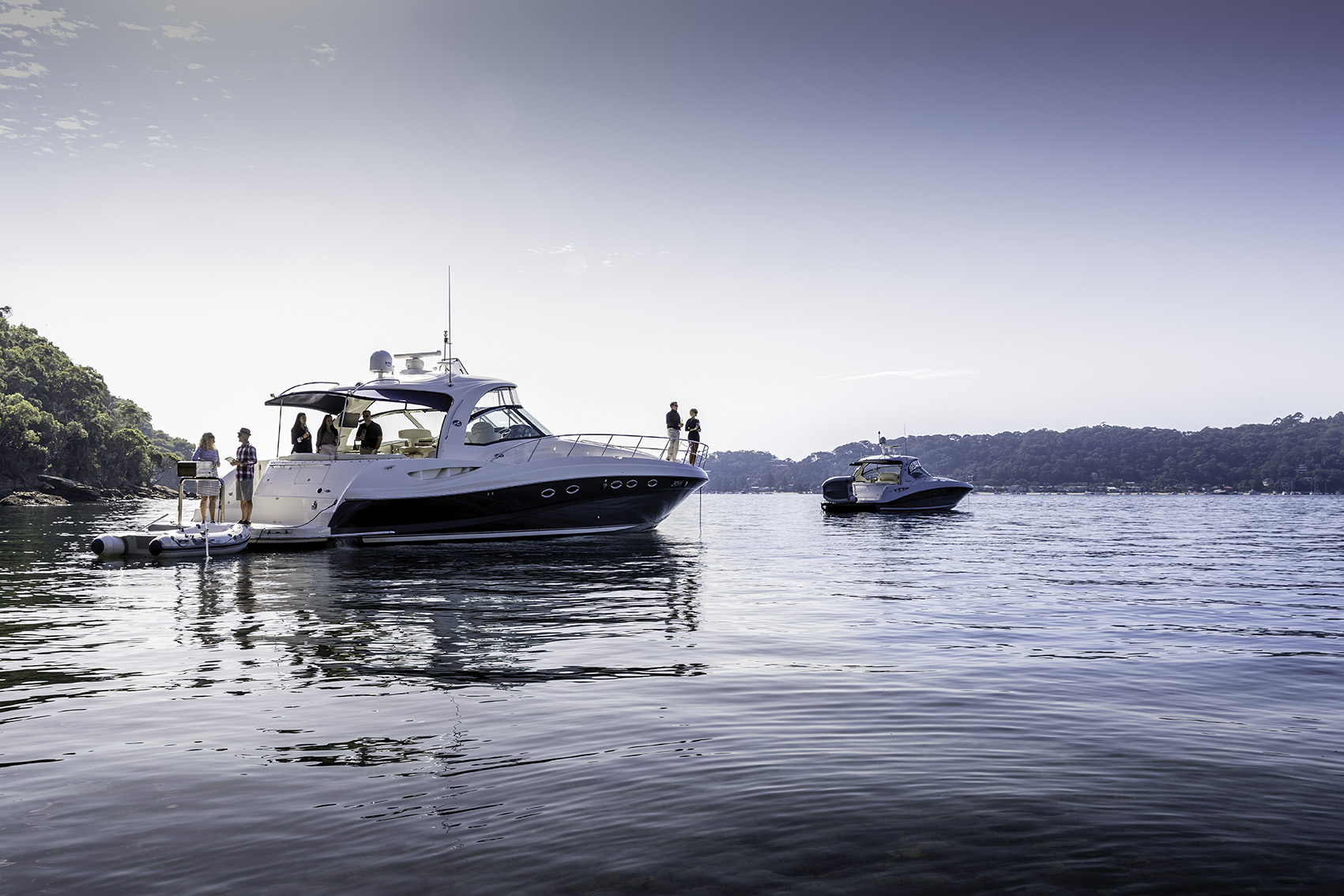
Join Sydney’s premier boating club and enhance your lifestyle

Ridetheducksofseattle is reader-supported. When you buy through our links, we may earn an affiliate commission. Learn more
What is a Berth on a Boat? (Sleeping & Docking Space)
Written by Anthony Roberts / Fact checked by Jonathan Larson
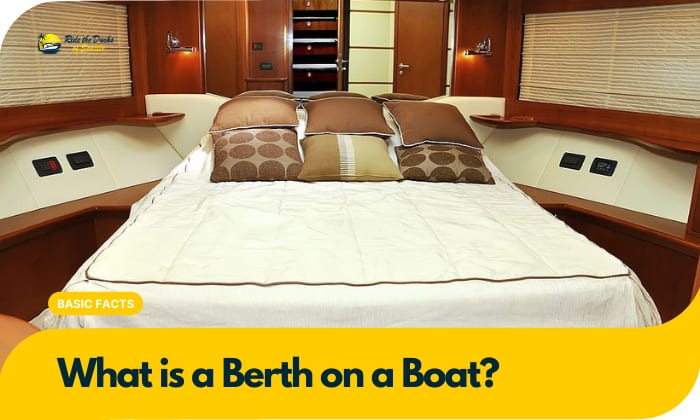
Many greenhorn boaters and aspiring watercraft owners find the “What is a berth on a boat?” riddle baffling. Although most folks liken it to mooring at the marina, some define it as a sleeping accommodation in a vessel.
And if you’re also confused, we prepared this article to clarify this boating terminology once and for all. So, please read on.
Table of Contents
1. Definition and Meaning
2. the purposes of the berth of a ship, 3. benefits of a berthing area on a ship or boat, 4. different types of sleeping berths, berth as docking space, berth as crew position, other berth meanings, berths as sleeping accommodations.
Determining the most accurate definition of berths requires appreciating two general types: sleeping and mooring. We will start with berths as sleeping accommodations, whether the berth of a ship or boat.
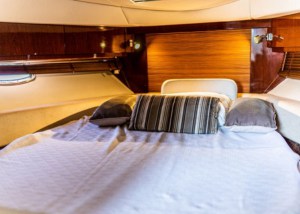
A ship’s berth is a bunk or a bed in a boat. This answers the question about the definition of berths.
As the space is smaller, berths are the perfect solution for a resting or sleeping area compared to larger ships that can accommodate extensive beds. Boaters and people traveling long distances are familiar with this term.
So, what does berth mean on a boat or ship? Being a sailor or an aspiring boater, this term is one of the essentials about boat anatomy.
We understand that there are many parts of a boat. The front of a boat is called a bow, while the back of the boat is called the stern. For the sides of a boat, the starboard is right, and the port side is left.
However, also knowing how to define berth is important for a better understanding of a boat’s anatomy. A berth or bunk is a sleeping area or bed, typically bunk beds on a ship.
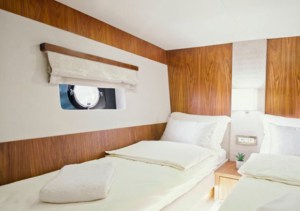
Sleeping on a sailboat isn’t easy. Instead of trying to sleep while sitting, sailor and boating enthusiasts use berths, bunks, or sleeping quarters to get some peaceful and comfortable shut-eyes.
And as sailing trips can last for days or even weeks, having a sailboat berth onboard proves much more important for sailors.
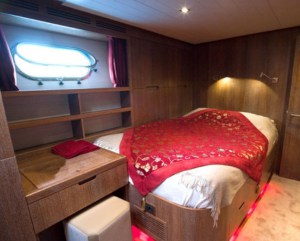
There are several benefits of using the sleeping area on a ship to get enough sleep while traveling out at sea.
- Fatigue prevention among seafarers and crews
Fatigue can take a toll on anyone’s health, whether you’re a seafarer or a simple boating enthusiast who explores the sea in days or even weeks.
Ensuring you get enough sleep while on your travels is important for both mental and physical well-being. It’s not only for proper rest or comfort but also for safety.
- Comfort and relaxation
After a long day, wouldn’t it be nice to curl up on the berth, listen to music, or read a book while relaxing? Whether a single or double berth, there’s no doubt that a berth bed is a useful investment to have in a boat.
There is nothing quite like the comfort it could give than having to find a corner in the boat where to rest after a long day.
- Protection and safety
As said, berths can refer to the berthing area for small boats or yachts. These areas can offer sailors temporary protection and shelter. In the case of a berth for a yacht or boat, it’s a sleeping area that offers comfort, quiet, and safety for everyone.
Typically, one is designed with privacy and safety, with a basic curtain for instant cover and noise reduction. It also allows privacy for the other passengers trying to sleep.
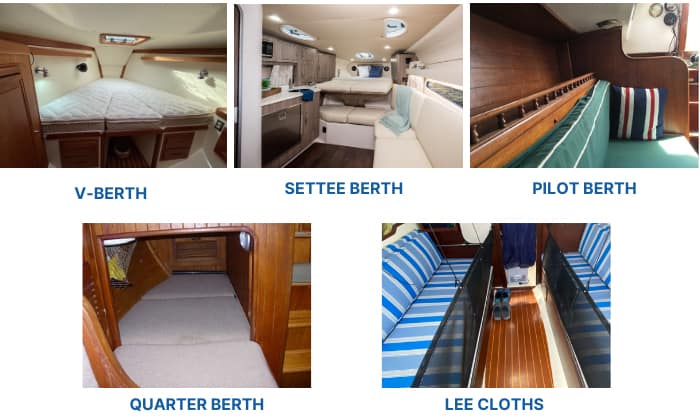
A sleeping berth offers some place of comfort and safety where you can relax without distraction, distress, and discomfort. It’s a small but comfortable place in a boat where crews, passengers, or sailors sleep. But what are the types of berths? Here they are.
- V-berth – This bed takes its name from its location on the yacht – toward the bow. And since the vessel’s front is tapered or angled, the “sleeping area” takes on a characteristic V shape.
- Settee berth – A quintessential fixture in small modern yachts, a settee is like a home’s sofa that transforms into a bed. It’s perfect for accommodating guests with a center table during the day and comfortable (albeit narrow) sleeping furniture at night.
- Pilot berth – One of the tightest and smallest sleeping accommodations on cramped boats, a pilot berth puts the sleeper mere inches from the deck’s underside.
- Quarter berth – It’s a tiny bunk under the boat’s cockpit to optimize limited space in small vessels.
- Lee cloths – This safety cloth tucks under the mattress, sandwiching the person and preventing him from falling off the bunk when sleeping in rough seas or when the vessel rolls or heels excessively.
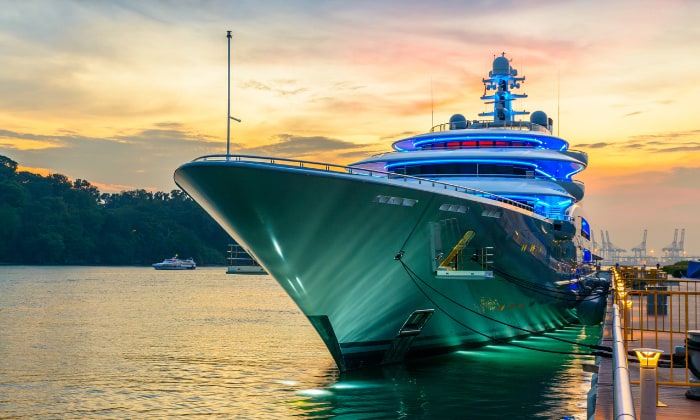
Another way to define the term “berth” is a mooring type at a marina or dock. Yes, the boating language can be very confusing sometimes.
Moorings, or berthings, are designated locations in a marina or port that boats use when not sailing. A berth port makes mooring safe because boats can load or unload either passengers or cargo from them.
In short, mooring in port is the tying or securing one’s boat to a secure object (i.e., mooring buoy, quay, bock, pier, jetty, or wharf). It is safer than just using an anchor to secure a boat in place.
Authorities or facility managers, such as a harbor master, assign a berth to a vessel. So, that’s basically the berthing and mooring of a boat.
Although berths on a watercraft can refer to sleeping accommodations or dock berth, the term can also mean a spot or position in a crew or team. For example, rowers will have starting “berths” on the boat.
You can also consider the other “berth” definitions or meanings. It can be understood as:
- The distance necessary to steer or maneuver a watercraft safely to avoid collisions
- An act of bringing the boat or ship to its “parking space” at the marina
Related Guides:
- Step by Step to tie a boat to a dock
- The average cost to dock a boat
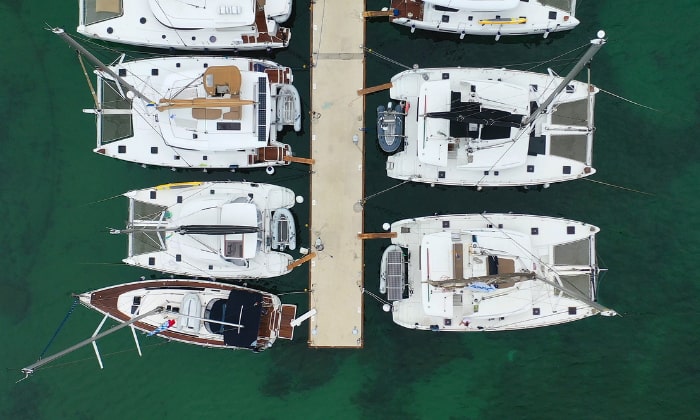
What are maintenance tips and best practices for berths?
Here are some tips for maintaining boat berthing and best practices in berthing a ship or boat.
- Clean canvas materials with clean water, mild soap, and a soft-bristled brush.
- Wipe vinyl surfaces with a sponge moistened with mild soapy water. Dry them with a soft cloth.
- Use an appropriate cleaner for maintaining wood elements.
- Study the marina you’re going to berth the boat in to avoid miscues and untoward incidents.
- Learn to assess the wind and tide and their impact on berthing a boat.
- Determine a bail-out point at the marina. Boaters must commit to berthing beyond this imaginary point.
Are there any size limitations for boats using berths?
Berthing restrictions vary across cities and states. For instance, San Francisco, CA’s South Beach Harbor requires vessels not more than a foot longer than the berth. Hence, you cannot “berth” a 34-foot yacht in a 32-foot berth.
As a rule, the berth should be at least 10 percent longer than the vessel berthing in the slot. For example, a 40-foot berth can only accommodate watercraft no more than 36 feet long.
What is the difference between a cabin and a berth?
A cabin is the space or “room” for a “berth.” Hence, you can have a four-berth cabin, meaning the “space” (the cabin) has four bunks or sleeping accommodations. That’s how we differentiate berth vs cabin.
Interestingly, some folks also find the dock vs berth argument baffling. We can simplify the differentiation by thinking of a dock as the “parking lot” for boats, while individual parking spaces or slots are the “berthing spaces .”
A bed is the most straightforward answer to the riddle, “What is a berth on a boat?” Our favorite slumberland furniture where we get vivid dreams isn’t any different. The only difference is the bed or bunk is in a watercraft.
Berth could also mean a vessel’s “parking space” at the dock. Or, it could refer to a position or slot in the crew or team. Of course, these definitions have boating implications. However, the most relevant description for a “berth on a boat” is sleeping accommodation.

Ten years of enjoying countless trips on boats never made me love them any less! So I am here to put all those experiences into good use for other boaters who want to have a safe and fun trip with their friends and families.

Berthing, Mooring, Docking and Picking up a buoy
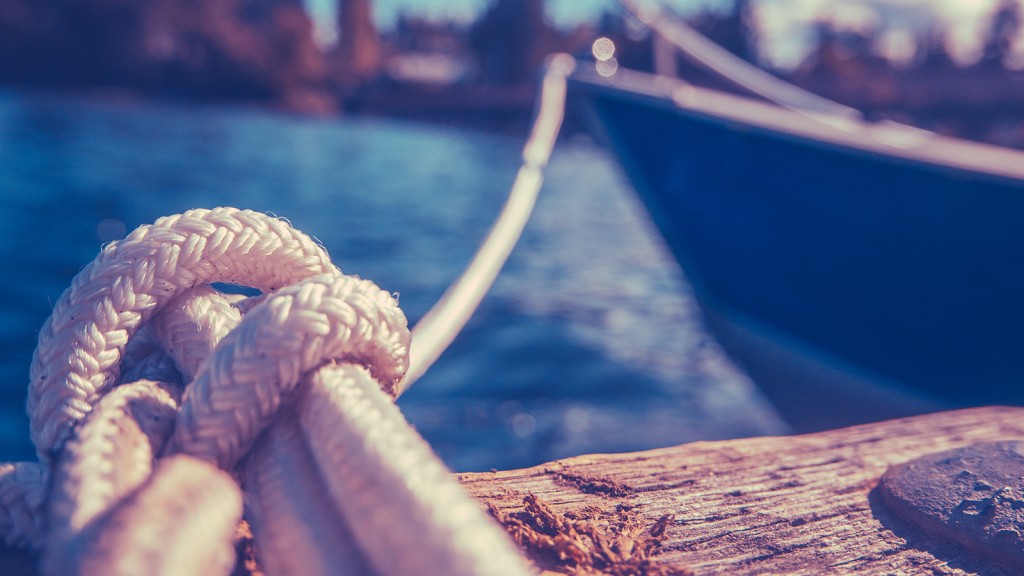
Mooring, Docking, and Berthing
The more you sail the better you become at it and this also applies to the knowledge you manage to acquire in the field. Expert sailors have a language of their own and it takes quite a long time to master it.
The difference between Mooring, Berthing and Docking
Nonetheless, there are a few basic terms any novice should get acquainted with. Three of them are the object of this post. Read on and discover the difference between mooring, docking, and berthing .
Mooring is one of the buzzwords you will have to get used to if you want to become a sailor. The process of mooring a vessel implies securing it to a fixed-point with the help of ropes or lines. By mooring, you basically make sure your boat is secured on a single point which, in its turn, is attached to the seafloor. This single point is called a marina mooring and it consists of an anchor, a float and a rode. By getting a mooring reservation , your boat will practically be anchored on the water.
Also, it’s useful to remember that there is a particular type of mooring which is known as the Mediterranean mooring. This implies that the boat is secured to the anchor in a manner that resembles the berthing technique. With this method your boat’s stern will be oriented towards a dock. The boat basically moves in reverse until it reaches the dock. Although it resembles a berthing maneuver, the point which keeps the vessel secured is not the dock, but an anchor, therefore, it is a mooring technique. As its name suggests, this technique is popular in Mediterranean marinas , more precisely those located in Europe where, due to lack of space, many boats need to be anchored to the same pier, occupying the space allocated to their width.
Docking and Berthing
Docking and mooring are often confused as they coincide up to a certain point. By docking your boat, you practically sail until you reach a fixed structure that allows you to get out on the land. This structure is called a dock and your boat is fastened to it.
Berthing means placing your vessel in the fixed location known as a berth. To make it easier to understand, imagine that the berth is basically your boat’s parking place. Berthing refers to the whole process of maneuvering your boat until it is secured in the fixed position in its berth. Therefore, we can say that berthing your boat means parking it in a designated area.
A mooring reservation is different from a marina reservation as the latter enables you to disembark directly, while the first doesn’t grant access to the shore.
Docking and Mooring Equipment
Both docking and mooring require typical equipment, let’s see what you need for each one of them so that you know what you should bring aboard on every occasion.
Marina moorings require you to have the following 3 essential components:
- anchor – it uses its heavy weight to keep the boat in a fixed position on the seafloor
- mooring chain – it connects the anchor to the floating buoy
- mooring buoy – the floating device connected to the anchor used to mark the place where the boat is moored

Docking also makes it necessary to equip your boat with the minimum gear which consists of
- fenders: these devices vary in size depending on each boat which they protect by acting as a buffer between the boat and the dock or other surrounding vessels
- lines: these are the ropes that help you fasten your boat to the shore
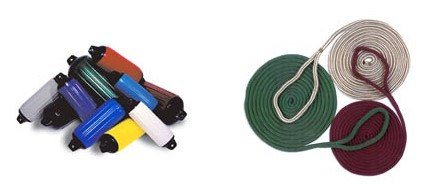
Other pieces of equipment such as dock steps, whips, hooks or other accessories are also a good addition aboard, especially if your boat spends a lot of time tied to the shore.
Berthing, Mooring and Picking up a Buoy – How to
Berthing, mooring and picking up a buoy are some of the most common notions you should get familiarized with if your passion is sailing. In this post, we are going to provide you with some basic information about each one of them. Read on and learn more.
1. How to Berth
Berthing refers to the process of mooring the boat in the designated places called boat berths. In simple words, when you’re berthing your boat, you’re ‘parking’ it in the allocated berth. There are few steps to take into account before and while berthing.
Firstly, no matter where you book berths, it’s always recommended to call before you arrive at the harbor. The marina’s staff will tell you exactly where your berthing place is, so that you will know where to head to and whether you should enter the port by coming in bow or stern.
Then, before you enter the port, you should get ready to berth by putting the fenders out of the boat and preparing your lines. You should have minimum four lines: for the stern, the bow and the two midship lines.
As you approach your boat berth, you should slow down so that you can fit the vessel into the designated space and then stop it so that you can moor it.
2. How to Moor
Boat mooring means tying a boat so that it is secured in a determined place. The art of mooring is one of the basic skills you will learn as a sailor. There are different ways of mooring as you can moor your boat by using a buoy, a dock or the sea bottom.
There are several items you need in order to moor:
- the bow line and the stern line, which will prevent the vessel from moving from right to left by connecting the bow cleat and the stern to the dock
- the fenders which will avoid any damage to your hull as they act as a cushion against the dock
- the cleat, which is the support you use in order to secure the boat’s lines
There are different types of knots that you can use to tie your boat to the moorings. Some of the most common ones are the following:
- the round turn and two half hitches: one of the most common mooring knots that can also be easily unfastened. This knot is performed in two steps; the first one (the round turn) means you pass the rope twice around the mooring ring or the dock post. The second step or the half hitch implies making a figure eight knot with your line around the cleat.
- the clove hitch: it provides a safe mooring because it relies on a very strong hold. The clove hitch is formed by two reversed half hitches. This is the best type of knot you can use if you want to secure your boat to a pole.
- mooring hooks are another mooring solution that can help you secure your boat fast. If you choose this method, make sure your lines are tight so that the water movement doesn’t loosen them.
One of the easiest ways of mooring is picking a place between the pontoon and another boat. If you have access to such moorings, you can use the other boat as a support to get to your pontoon, then throw the lines and fasten them to the cleats.
There are different ways of mooring your boat; you can use the midship line or the stern line if you approach the pontoon stern first.
The typical mooring method used for larger boats is by using a spring line that will prevent the vessel from moving forward or backward. These lines are longer than the lines of the bow and the stern and actually exceed the length of the vessel. Spring lines connect the dock cleat and the bow cleat with the stern cleat.
3. How to pick up a mooring buoy
Boat buoys are the floating objects used in ports to direct the vessels and indicate any possible dangers. Picking up a buoy can be a tedious duty, but with sufficient practice, you’ll tackle this issue. When you’re looking for a buoy, you have to understand how it is positioned. This way, you can avoid causing unpleasant damage to the boat’s rudder or the propeller.
When you approach the buoys, from the helm, you should consider the force of the wind and the tides and go against which one is strongest. Ideally, the buoy will be located off the starboard bow.
When you prepare to pick the buoy up, try to do it from one side and not ahead, to ease your work. You can use a hook to grab the buoy by passing a line around it and dragging it to the boat. If the buoy has no pick-up line, these hooks are ideal for creating a connection between the buoy’s ring or hoop and your boat. In some cases, both the pick-up line and the hook might be missing so, you have to drag the buoy by using a line to form a lasso. The line chosen for this task has to be one that will sink not float. If you grab the buoy by this means, it should only remain in the lasso before you properly moor. Therefore, you should remove the lasso and properly secure the buoy with a line. The ends of the line have to be secured to the bow cleats. And if you are planning a longer stay, you should take an extra step for safety and use an additional line with full turn. This way, you can also prevent boat scratches.
Alternatively, you can pick up buoys by approaching them astern, which will help you fasten the lines far easier. However, you should pay attention as it’s easy to damage the propeller if you are not careful.
Berthing, mooring and picking up a buoy are just a few of the basics you have to learn if you want to build a passion for sailing. We can help you with plenty other useful sailing tips and recommendations, so check out the rest of our articles.
Berths in the Mediterranean
Berths in the Mediterranean can be found in different top tourist destinations in Europe. The South of the old continent is one of the most appreciated cruising areas in the world. The best regions to sail to in Europe are located in Italy, France, Spain, Croatia, and Montenegro. Discover the most beautiful areas in these countries where you can book marina berths.
- Italy . The most elegant and well-provided slips in Italy are located in: Sardinia, Sicily, Campania, Calabria, Puglia, Tuscany, Latium, Liguria, Veneto, Emilia Romagna.
- France . The South of France is famous worldwide for its stunning Côte d’Azur. If you are looking for slips in France in the area, try Saint Tropez, Antibes, Cannes, Nice. Another must-see is the island Corsica.
- Spain . Moorings for rent in Spain are typically affordable and easy to sail to. Some recommended regions include the Balearic Islands, Barcelona, Costa Calida, Costa Blanca.
- Croatia . The most popular moorings for rent in Croatia are found in Istria, Dalmatia, the island Hvar. Emblematic cities to sail to include Split, Dubrovnik, Zadar.
- Montenegro . Among Montenegro slips, we suggest you book a berth in the Gulf of Kotor (and take the chance to visit the homonymous city), the Budva Riviera or Bar.
These are the essentials of docking vs mooring , but much more can be said, so stay tuned to learn useful things about your passion for boats. And don’t forget that we’re always here to help you plan your next sailing vacation by providing you fast and easy marina online booking !
Rent berths and moorings in Europe
Leave a comment cancel reply.
Your email address will not be published. Required fields are marked *
Yachting Monthly
- Digital edition

An expert guide to box berthing
- Chris Beeson
- September 9, 2017
Dutch boatbuilder Eeuwe Kooi has been box berthing all his life. He shows Chris Beeson how the pros do it

KM Yachtbuilders' Eeuwe Kooi instructs Theo on the finer points of box berthing aboard his Bestevaer 45ST PURE Credit: Graham-Snook.com

Eeuwe Kooi, owner of KM Yachtbuilders in Makkum, the Netherlands, has been box berthing for years and knows all the tricks
If you’re ever tempted to explore the wonderful cruising ground that is the Baltic, you’ll have to moor in box berths. Although almost entirely unknown in the UK, they are very common throughout northern Europe. They’re abundant in the Netherlands as well as Scandinavia, and you’ll even find them in Belgium. Some have wooden posts at one end and a pontoon at the other, others have buoys with rings on top instead of posts but all form a box of sorts in which a boat is moored. Most Baltic boats prefer to moor bow-to the pontoon as it gives more privacy when you’re sitting in the cockpit. This is why most Baltic boats have walk-through pulpits and often bow boarding ladders too. Boats with closed pulpits may choose to moor stern-to for ease of boarding.

Box berths can involve wooden posts, like these ones at Yachthafen Konstanz, in Germany
The key to box berthing is getting the windward bow or stern lines onto the posts as you go past. Standing amidships, at the point of maximum beam, if you can get close enough to drop a bowline or spiced loop over the post, all you need to do is adjust the mooring line on the cleat to get the boat in position. Dropping a bight (a doubled line) over the post is more reliable, as you can’t be sure of being close enough to drop over a loop whereas you can throw over a bight, but you do then need to run the working end through a fairlead and get it onto a cleat, which takes slightly longer.

Box berths can involve rings atop mooring balls, as we see here in Kalmar Harbour, Sweden
A doubled line offers more options when it comes to leaving. If you use a loop, replacing it with a doubled line that you can slip from deck is a bit tricky if you can’t reach the post. You’ll need to be very sure that you can remove the bowline or loop as the boat exits past the post with you standing amidships. If you can’t, you’ll have to leave the mooring line behind. As a general rule it helps to motor ahead against the stern line to control the boat, to use the stern line as a bow spring. So if you’re going in bow-to, get the windward stern line round the post, load it on a winch at the helm and hand it to the skipper, who can motor against the stern line, easing and snubbing it while liaising with the crew at the bow to get the right distance off the pontoon. Going in stern-to, it’s the same process but get a line onto the windward pontoon cleat first so the skipper can motor against that.

Box berths galore in Yachthafen Herrenbrücke on Lake Constance, Germany
Eeuwe believes bow in is easier, but it can be trickier to get out, simply due to the vagaries of running astern at low speeds. He also says the most important lesson is ‘Don’t stop!’ as things could go horribly wrong if the boat gets blown down a row of posts and bows. Even if you can’t get a single line on, once in the berth you can rest on the leeward boat’s fenders while you sort yourself out.
Got a rubbing strake?

Strakes are evident on thisSwedish Hallberg-Rassy 412
After your first attempt at box berthing you will understand perfectly why almost all Swedish- and Dutch-built boats have rubbing strakes. On arrival, when you contact the harbourmaster, you may be asked for your beam as well as length. For obvious reasons, don’t be tempted to fib on either in the hope of a cheaper berth. If you can’t get hold of the harbourmaster, look for a likely-sized berth, ideally a metre wider than your beam, with a green tag. Berths tagged red are unavailable. What do you do if you haven’t got a strake? Assuming the posts are far enough apart for you to be able to get in without touching them, there’s no guarantee you’ll thread the needle. Fenders aren’t much use and may even stop your progress into the berth if they get jammed between hull and post. Many recommend taking two thick manila lines and rigging them from bow to stern running along the topsides at the most beamy point of the boat: just under the toerails on most boats, lower down if the topsides have abit of tumblehome. If you can’t find thick manila, try foam pipe lagging on a thinner line. Have fenders rigged both sides but lying on the sidedecks rather than over the side, ready to kick over once you’re past the posts. If you’re going in stern-to, rig a big fender, a ball ideally, on the transom in case your bow crew doesn’t snub the bow lines in time, and another on the leeward quarter in case the crew snubs the bow line too soon and you blow down onto the leeward boat. Communication is key.
Entering bow to

Standing midships, Theo drops the windward stern line over the post as it passes then walks it aft, runs it through a fairlead and hands it to Eeuwe at the helm, who puts it on a winch. Theo then goes forward to rig the windward bow line
Rig two bow lines and two stern lines and bring the stern lines outside the lifelines to midships. Rig fenders but keep them on the sidedecks until you’re in the berth. Approach into wind or stream, whichever is stronger. If the skipper has two crew, have one either side at midships so they can drop lines over both posts as they pass. With just one crew, choose the windward post and rig a big fender on the leeward bow. Once the windward stern line is over the post, take it aft, put it on a winch and hand it to the skipper, then look after the windward bow line. After stopping the boat with a burst of astern, the skipper can motor ahead against the stern line and adjust it to get the right distance off the dock, using crew feedback. The crew drops the windward bow line over a pontoon cleat and secures it at the bow. Adjust bow and stern lines and use the engine to get the leeward stern line over the leeward post, then do the same to get the leeward bow line on. Finally, rig a bow spring from the windward post to your midships cleat if the stern is level with the posts, to keep you off the pontoon, then deploy your fenders. If you’re alone, try to get a windward stern line on and either motor against it, or rest on the boat to leeward, which should have fenders out, while you sort out your lines. Take your time. Some skippers prefer crossed stern lines but walking the windward stern line to the leeward quarter outside everything takes time. If you want the added comfort, put the windward stern line on the leeward cleat, drop it over the post and secure to the windward cleat, vice versa for leeward, then swap the working ends once stable.

1. With bow and stern lines rigged, the crew stands midships to drop the windward stern line over the post, then walks it aft and gives it to the skipper who loads it on a winch. 2. Thecrewgetsthe windward bow line on and communicates distance off to the skipper, who can either motor ahead and ease the stern line, or motor astern and haul it in. 3. All lines are rigged and the boat is centred in the berth. If boat and berth are about the same length, rig a bow spring from the windward post to midships to keep her off the dock.

TOP TIP: If you’re berthing single- TIP handed, get the stern line on if you can, then motor gently ahead against it, or rest on the fenders of the leeward boat while you sort out your lines.
Leaving bow to

To help counter the effect of wind on the bow, Eeuwe tells Theo to haul on the windward bow line just before slipping. With the engine in neutral, Eeuwe hauls on the spring to ease her off the dock before lifting the spring off the post
Again, if you use a loop instead of a slipped line for your bow lines, change them for doubled lines that can be slipped from deck. With the engine running, slip the leeward stern line and put the windward stern line on a winch near the helm. The skipper then engages ahead, motoring against the stern line and the crew eases the leeward bow line. On boats with beamy sterns, this may create a turning moment that drives the bow to windward. If that happens, drop some revs until she’s stable in the berth, then the crew slips the leeward bow line. When the skipper’s checked there’s no traffic and is ready to go, the windward bow line is slipped, there’s a big burst of astern and the skipper spins the windward stern line off the winch as the crew comes aft to haul it aboard. If a strong crosswind threatens to blow your bow onto your leeward neighbour, put your biggest fender on the leeward bow before removing any lines, just in case. To help prevent that happening, the crew, wearing gloves, can let the windward bow line run around the cleat, gently snubbing if necessary but never stopping the boat, so that it acts something like a drogue to keep the boat straight when leaving the berth – but remember to slip it the moment the bow is clear of the post and boat to leeward. If it’s really blowing, a midships breast line that can be dropped over the windward post is a useful precaution to keep you clear of the leeward post, eased and snubbed as the boat runs astern and slipped once you’re clear. Once clear of the box, bring the stern into the wind. The bow will blow down and help speed up your rate of turn.

1. Slip the leeward bow and stern lines first. In strong crosswinds, a ball fender on the leeward bow offers protection to a leeward boat, and a midships spring (see Top Tip, below) works well. 2. If there is a crosswind, just before the skipper is ready to leave, the skipper tells the crew to haul on the windward bow line to allow for the bow blowing down to leeward on exit. 3. With that done, the skipper tells the crew to slip the bow line before lifting off the stern line and engaging astern. In a crosswind the stern line could just be slipped.

Top Tip: You can rig a midships spring to a winch near the helm. Motor against it to steady her as you slip your lines. This pushes the bow to windward. Exit with a burst of astern and slip the spring
Entering stern to

Eeuwe is checking to make sure that Theo has got the windward bow line over the post. As Theo then takes up slack, Eeuwe checks the stern where Kieran is ready with the windward stern line, which will go onto a winch to adjust distance off
Rig bow and stern lines with the windward stern line ready to go round a winch near the helm, and fender the leeward quarter and transom. Approach by running astern into the wind and, if it’s strong, keep on a fair bit of way to prevent the bow blowing off as the boat straightens up into the berth. The skipper needs to get the boat close enough to the windward post to let the crew drop the bow line over it. When that’s done, the crew goes forward with the bow line. Once the skipper is close enough to drop the windward stern line onto a pontoon cleat, the boat is stopped with a burst of ahead, the skipper drops on the windward stern line and takes up the slack on a winch as the crew secures the bow line. Now the boat is in the box and not drifting to leeward. If the berth is of a size that the crew can ease the windward bow line to get a bow line round the leeward post, then centre her in the berth, all well and good. Otherwise, with the skipper at the helm, the crew at the bow and the engine idling in forward, it’s a case of easing out the stern line round the winch and the crew adjusting the bow line until the boat is close enough to the leeward post to drop on the leeward bow line. With that done, the crew eases both bow lines and the skipper hauls her astern, either with the winch or the engine, drops the leeward stern line over a pontoon cleat and secures it. Adjust all lines to get the boat the right distance off the pontoon and square in the berth. If the boat is almost the same size as the berth, adding a stern spring from the windward post to a midships cleat will keep her off the pontoon.

1. With windward and leeward bow lines rigged, the crew stands midships to get the windward bow line on the post as it passes, which is then taken forward and the slack is taken up. 2. When the transom is close enough to get a stern line over the pontoon cleat, the skipper stops the boat with a burst of forward, gets the stern line on and loads it on a winch. 3. By easing the windward bow and stern lines, and using engine power, the boat can be manoeuvred in the box to rig the leeward bow and stern lines, then squared up in the berth.

If there’s no wind, with one stern line on a winch and the other eased, the skipper can motor against the stern line to haul the bow across to the post so the crew can rig the second bow line.
Leaving stern to

Eeuwe is ready to leave the berth so Theo hauls the bow a touch to windward to counter the effect of any crosswind. Hauling on the windward bow line before slipping it would have been much less precarious than this looks
Slip bow and stern lines off the leeward side. If you use loops instead of bights, replace the windward ones with doubled lines that can be slipped from on deck. Put the windward stern line onto a winch near the helm so that the skipper can slip it. The crew walks forward and, when the skipper has checked for traffic and is ready to go, the crew slips the windward bow line and heads to the cockpit as the skipper spins the windward stern line off the winch, and the skipper, or preferably the crew, hauls in the line. If there’s a bit of a crosswind, when the skipper gives the order to slip, the crew can haul the bow a little to windward before slipping the bow line and coming aft, as this buys some time if the bow blows off. The skipper or crew then hauls in the stern line as the skipper gives the throttle a burst and off you go. If you need to turn into a strong wind, you’ll need a windward bow line that is longer than twice the length of the boat, doubled so you can slip it from deck, and low down on the post. Let it run until the stern is clear of posts and boats then, as the skipper turns to windward, snub the line to make a bow spring and the bow will haul to windward. Then slip the line and haul it in very quickly to avoid fouling the prop. The line needs to be low on the post so that, when snubbed, it slaps against the hull instead of taking out your stanchions. The skipper needs to measure speed to avoid tearing cleats off the deck, too. If your lines aren’t long enough, a midships line will suffice. However, running astern upwind is easier.

1. The leeward bow and stern lines have been slipped and the windward stern line has been rigged as a slip, loaded onto a winch. The crew at the bow is waiting for the signal to slip. 2. When the skipper sees a gap in the traffic, the crew is instructed to slip the bow line as the skipper slips, or flicks off, the stern line and engages ahead with a lively burst of throttle. 3. If the windward stern line was slipped, the crew comes aft to haul it in before there’s a chance of it getting near the prop. The skipper steers the bow downwind.

Top Tip: If you need to leave bow to windward, use a slipped windward bow line at least twice as long as the boat. When the stern is clear of posts and bows, the crew snubs the windward bow line, hauling the bow to windward
- New Sailboats
- Sailboats 21-30ft
- Sailboats 31-35ft
- Sailboats 36-40ft
- Sailboats Over 40ft
- Sailboats Under 21feet
- used_sailboats
- Apps and Computer Programs
- Communications
- Fishfinders
- Handheld Electronics
- Plotters MFDS Rradar
- Wind, Speed & Depth Instruments
- Anchoring Mooring
- Running Rigging
- Sails Canvas
- Standing Rigging
- Diesel Engines
- Off Grid Energy
- Cleaning Waxing
- DIY Projects
- Repair, Tools & Materials
- Spare Parts
- Tools & Gadgets
- Cabin Comfort
- Ventilation
- Footwear Apparel
- Foul Weather Gear
- Mailport & PS Advisor
- Inside Practical Sailor Blog
- Activate My Web Access
- Reset Password
- Customer Service

- Free Newsletter

Blue Jacket 40 Used Boat Review


Catalina 270 vs. The Beneteau First 265 Used Boat Match-Up

Ericson 41 Used Boat Review

Mason 33 Used Boat Review

How to Create a Bullet-Proof VHF/SSB Backup

Tips From A First “Sail” on the ICW

Tillerpilot Tips and Safety Cautions

Best Crimpers and Strippers for Fixing Marine Electrical Connectors

Polyester vs. Nylon Rode

Getting the Most Out of Older Sails

How (Not) to Tie Your Boat to a Dock

Stopping Mainsheet Twist

Fuel Lift Pump: Easy DIY Diesel Fuel System Diagnostic and Repair

Ensuring Safe Shorepower

Sinking? Check Your Stuffing Box

What Do You Do With Old Fiberglass Boats?

Boat Repairs for the Technically Illiterate

Boat Maintenance for the Technically Illiterate

Whats the Best Way to Restore Clear Plastic Windows?

Stopping Holding-tank Odors

Giving Bugs the Big Goodbye

Galley Gadgets for the Cruising Sailor

The Rain Catcher’s Guide

Sailing Gear for Kids

What’s the Best Sunscreen?

UV Clothing: Is It Worth the Hype?

Preparing Yourself for Solo Sailing

R. Tucker Thompson Tall Ship Youth Voyage

On Watch: This 60-Year-Old Hinckley Pilot 35 is Also a Working…

On Watch: America’s Cup

On Watch: All Eyes on Europe Sail Racing

Dear Readers
- Safety & Seamanship
Seaberths Examined
The design of offshore production-built sailboats often overlooks a crucial element in crew comfort and safety—the seaberth. so what qualifies as a proper seaberth.
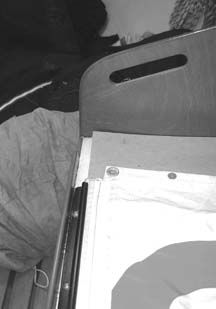
Whether you’re crossing the Gulf Stream to Bermuda or the Bahamas, racing to Halifax or Hawaii, or just cruising coastal waters, having proper sea-berths for the off-watch crew is an often neglected, yet vitally important element of a good offshore boat. Why are good seaberths a shipboard necessity? Anytime a vessel is underway for more than a few hours, a rested skipper and crew are essential for the safe operation of the boat.
Even in this day of sophisticated electronic navigation, boats are occasionally lost while entering an unfamiliar port at night or in foul weather. Often a major factor contributing to dire mishaps like these is the lack of seaberths on board, which can lead to an exhausted and mistake-prone crew that’s yearning to get ashore as soon as possible. A well-designed seaberth not only ensures comfort for its occupant during time afloat, but also provides the security necessary to minimize the possibility of injury from being launched across the cabin in the case of a knockdown, broach, or other drastic change in course.
We are beyond the age of Lord Nelson’s navy when hundreds of sailors aboard a man-of-war slept in hammocks slung a regulation 18″ apart. For generations of sailors, hammocks were the seaberth of choice. These simple devices maximized space, stayed comfortably level as Jack Tar gently swung to the roll of the ship, were easy to enter and exit, and did double duty when stacked as protection against incoming cannon balls.
These days, unless you’re single or double-handing, in which case one seaberth may be sufficient, half the number of crew, plus one, is the minimum number of proper seaberths PS recommends.
An extra seaberth allows non-watchstanding guests or seasick crew to be comfortable, yet out of harm’s way while the boat is being worked. If unoccupied, an extra seaberth provides secure stowage for duffles, laptops, or other sensitive items. To prevent frustration and seasickness, sea-berths should be assigned, located, and prepared in advance of setting sail, especially at night or during heavy weather when a tired crew just wants to undress and fall into a welcoming bunk, rather than face the chore of emptying and making up the berth.
What makes a proper seaberth? Despite a broker’s alluring words or a glossy advertisement featuring flowers and hors d’oeuvres in a seductive interior, a seaberth is not just a salty name for a bunk cushion secured by fiddles. Location, dimensions, and detailing all are important elements as a functional seaberth is more than the sum of its parts. Size, shape, lighting, ventilation, noise, cushions, ease of access, lee cloth/bunkboard functionality, view of navigational instruments, even the quantity of pillows are the more important considerations when designing and fitting a seaberth.
Location, Location, Location The best location for seaberths can be a lively topic of discussion. Generally, a good seaberth is situated aft of the mast, where the pitching motion is least. Although a forward cabin may occasionally be an excellent place to sleep, particularly while motoring in flat water or sailing downwind in consistent breezes, a forward cabin is not a good location for a seaberth due to the increased motion underway, the noise of waves drumming against the flat panels of the bow, the triangular shape of the V-berth, and the difficulty of providing leak-free ventilation.
Because the motion of a boat is less appreciable lower in the hull, a good cruising seaberth is best located lower, rather than higher in the interior. Although rarely acceptable on a racing boat, sleeping on the leeward side provides an excellent compromise of reduced pitch, roll, and noise, as a leeward bunk is low in the boat and gravity becomes an ally to assist in keeping one securely in the bunk.
Additionally, the lullaby of water swishing along the lee rail can sooth one to sleep. In an emergency, a comfortable temporary seaberth can often be improvised by laying a bunk cushion on the cabin sole (the lowest habitable location on most boats,) and using sail bags and duffles as cushioning.
Ideally, a seaberth should be located parallel to the centerline of the boat. If not, as the boat heels, the bunk’s lengthwise axis will change from horizontal. In such a case, the more the boat heels, the less effective the bunk becomes, as sleeping with your feet higher than your head, (or vice versa), may cause vertigo or other unpleasant effects. Even a few inches of bunk asymmetry relative to the centerline can make a big difference. This rules out the use of athwartships (crosswise) berths as a seaberth while underway.
A proper seaberth is at least 76″ in length, 22″ to 28″ wide along its entire length, and a minimum of 24″ from the top of the bunk cushion to the overhead. Seaberths of these approximate dimensions provide a snug fit for security, yet allow enough volume for pillows, blankets, clothing, and the taller or wider-bodied crewmember. Any narrower or shallower, and the seaberth begins to assume the ambiance of a coffin with the comfort of a torpedo tube. Any wider, and the occupant can roll uncomfortably from side to side as the boat rolls, pitches, or yaws. Extra wide or double berths can effectively be converted into two seaberths using lee cloths and/or removable bunk boards.
Except for the proximity to the engine room, the time tested aft “quarter berth,” as found on a Cal 40 and many other mature designs, is often the quintessential seaberth. Even more modern designs such as the Catalina 42 can benefit from retrofitted seaberths.

Another excellent seaberth is a main cabin settee. With a large number of crew, settees sometimes suffer from traffic and disruption due to cabin lights, galley and nav station noise, and sunlight from the cabin ports and hatches. But with the use of lee cloths, window and hatch curtains, eye shades, and foam ear plugs, most such disruption can be minimized for those sailors using a settee as a seaberth.
The easiest to install, and perhaps the most comfortable seaberth is the pipe berth. Pipe berths have been around for generations, and remain the seaberth of choice on race boats where windward side crew weight is paramount.
Pipe berths are usually rectangular aluminum or carbon fiber tubular frames that are hinged to the hull, and are lightweight, strong, and can be racked two, or even three high. Even a frame constructed of PVC plumbing pipe, or a hinged plywood board with a cushion can make an inexpensive yet comfortable pipe berth.
Pipe berths offer the advantage of being easily retrofitted in many areas aboard even the smallest boats. Lowered to a near vertical position, a pipe berth can also double as a back rest for a lower bunk or settee. Surprisingly, the biggest advantage of pipe berths is their comfort, as they can be lowered for access, then leveled for sleeping using the 4:1 purchase system.
Another excellent seaberth is the pilot berth, located above and outboard of settees on some boats. In fact, the best seaberth on a boat like the Santa Cruz 50 or 52 is the main cabin pilot berth, as it is out of the way of traffic and noise.
But on many designs, the pilot berth is not an option, as this space is dedicated to book shelves, entertainment consoles, and even water ballasting tanks. Unless well designed and constructed early on, pilot berths are often too narrow, uncomfortably shaped, or compromised by the boat’s frames, stringers, chain plates, or other hull structures.
For shorthanded sailing, a “wet berth” is a vital asset to boathandling and safety. A wet berth is a secure rest area protected from inclement weather where the skipper or watch stander can rest (often in foulies), immediately available to lookout, steer, trim, or perform other boat handling responsibilities. A wet berth might be a cushion placed on the floor of the cockpit, in the lee of a dodger, or below in a pilot house where the navigation instruments are readily visible. Ideally, a wet berth is below out of the elements, adjacent to the companionway, with a good view of the compass, radar, depth sounder, and chart plotter, and with the autopilot and auxiliary engine controls also readily at hand.
Lee Cloths Every good seaberth will benefit from fine-tuning to provide comfort. Except for pipe berths, a rectangular lee cloth is the primary means of securing an occupant in a seaberth. Although a satisfactory lee cloth can be made from old sail cloth, the best lee cloths are sewn using breathable acrylic canvas such as Sunbrella™.
Where possible, lee cloths should extend along the full length of the bunk and be secured in a vertical plane, or angled slightly inward toward the sleeper. Unfortunately, commercially available lee cloths, such as those available at West Marine, are too short (45″) to restrain both head and feet from hanging out of the seaberth. In addition, many commercially available lee cloths are made of less than substantial vinyl plastic mesh, which may give an unpleasant feeling to bare skin and rip at inopportune moments. Consequently, most good lee cloths are custom-made.
As noted, a lee cloth should be as long as possible, and rise at least 12″ above the top of the bunk cushion. The bottom edge of the lee cloth can be secured with either a batten and screws, or through bolted at 6″ centers to the bunk top. An even better method of securing a lee cloth is a bolt rope that is sewn to the bottom edge of the cloth and then inserted in a bolt-rope track, (plastic or aluminum, available from most canvas makers), which is screwed to the bunk top. This allows for easy removal of the lee cloth for washing.
If the bunk cushion is double wide and lee cloth placement is difficult, bunk boards can also be used in lieu of lee cloths. In the situation where neither a bunk board nor a lee cloth is an option, a low-stretch line can be inserted and sewn along the bottom edge of the lee cloth, and tautly secured to points at the head and foot of the bunk cushion, so that the bottom of the lee cloth rests along the top of the bunk cushion. When not in use, lee cloths can be laid flat and tucked out of the way under the bunk cushion.
Lee cloths are often subjected to considerable abuse and side force, so the top edge and corners of the lee cloth need reinforcing. The grommets on the upper corners should be laced taut with 1/4″ line on an upward-sloping 45-degree angle to securely anchored padeyes or the equivalent. And the two mid grommets need to be tensioned vertically to overhead padeyes. Even better, they can be run over an overhead handrail. The handrail will also assist the berth occupant in recovering from the horizontal position.
Tensioning lee cloth lines is usually a haphazard affair. The best adjustable knot is the rolling hitch, which can be slid along the support line to achieve proper tension. A better solution is a friction plate that can be fashioned from a simple 2″ x 4″ x 3/16″ rectangle of wood, or a dowel, with two holes drilled into it that provide an easily adjusted purchase.
Seaberth Accessories Next to location and lee cloths, ventilation is the most important consideration for a good seaberth. Unfortunately, ventilation from nearby opening ports often admits water as well as air. An excellent alternative is the use of an electric fan. PS recommends that sea berths be ventilated with a fan mounted at the head of the bunk where possible. Such a fan should be quiet, adjustable, miserly on power consumption, and produce no radio interference.

Lighting for a seaberth is available in many options. One good option that helps maintain night vision is the use of a red-white combination light. Even having a battery powered headlamp available in each seaberth is sufficient.
Another aid for a good seaberth is the use of foam earplugs. While they may not be for everyone, they can dampen annoying sounds and muffle engine and radio noise to an acceptable level. Of course a skipper or navigator must always sleep with one ear open, and leading a “signal line” from the seaberth to the helm can facilitate this awareness. This is particularly useful when sailing shorthanded, or with inexperienced crew.
As experienced distance racers know, when possible, crew should sleep in seaberths with their feet forward. This practice lessens the chance of head or neck injury in the event of unanticipated rapid deceleration, as in the case of a collision with a whale, or when being tossed about by larger than average waves. If venturing into areas of potentially rugged upwind conditions such as the Baja Bash, crossing Hawaiian Island channels, or the Windward Passage, it is also recommended to consider installing seat belts across each seaberth as a measure to prevent airborne crew.
Such a measure would have been appreciated earlier this winter when a crewmember aboard one of the boats competing in the Global Challenge suffered a dislocated hip and bone fragmentation after he was thrown from his berth when the boat became airborne following a hit by a particularly large wave while en route from Australia to South Africa.
Safety is paramount in this event, and the 72-foot vessels competing have purposely designed seaberths for all off-watch crew. Granted, relatively few of us will ever voyage through this patch of ocean aboard our boats, but the point is clear—offshore and ocean sailing vessels should have good, properly equipped seaberths. And given the growing popularity of cruiser-friendly rallies and races—the ARC, the Caribbean 1500, the Newport-Ensenada Race, and the Baja Ha-ha among them—having a sufficient number of properly equipped seaberths on board shouldn’t be regarded as optional.
Also With This Article “Where are the Seaberths?”
RELATED ARTICLES MORE FROM AUTHOR

Safeguarding Sailors via Passage Guardian
Really REALLY good article; and I am relieved as well as amused to discover that the saloon berths in my own little cruising boat fit all of Darrell’s specifications to a tee. Thanks for the enlightenment and confirmation!
LEAVE A REPLY Cancel reply
Log in to leave a comment
Latest Videos

Cabo Rico 34 Boat Review

Super Shallow Draft Sailboat: The Leeboard Sharpie

Hans Christian 41T – Boat Review

Seven dead after superyacht sinks off Sicily. Was the crew at...
Latest sailboat review.

- Privacy Policy
- Do Not Sell My Personal Information
- Online Account Activation
- Privacy Manager

4 Essential Sailing Maneuvers
- July 9th, 2016
- Sailing Skills
What is a good sailing school ? I would say, it´s a place where you won´t just be taught how to pass an exam or how to get a certain certificate, but where you can gain skills both in sailing abilities as well as in seamanship. It certainly depends on the skipper you´ll get: And I can say that I again was so lucky with my skipper during the SKS (equivalent to the RYA Coastal Skipper) a few weeks ago. (You may read the practical sailing education here and the examination day here ). Dietmar, his name, told us right from the beginning what his intentions have been: Teaching us how to sail and how to act as a thorough skipper. And yes, there´s an exam we want to pass.
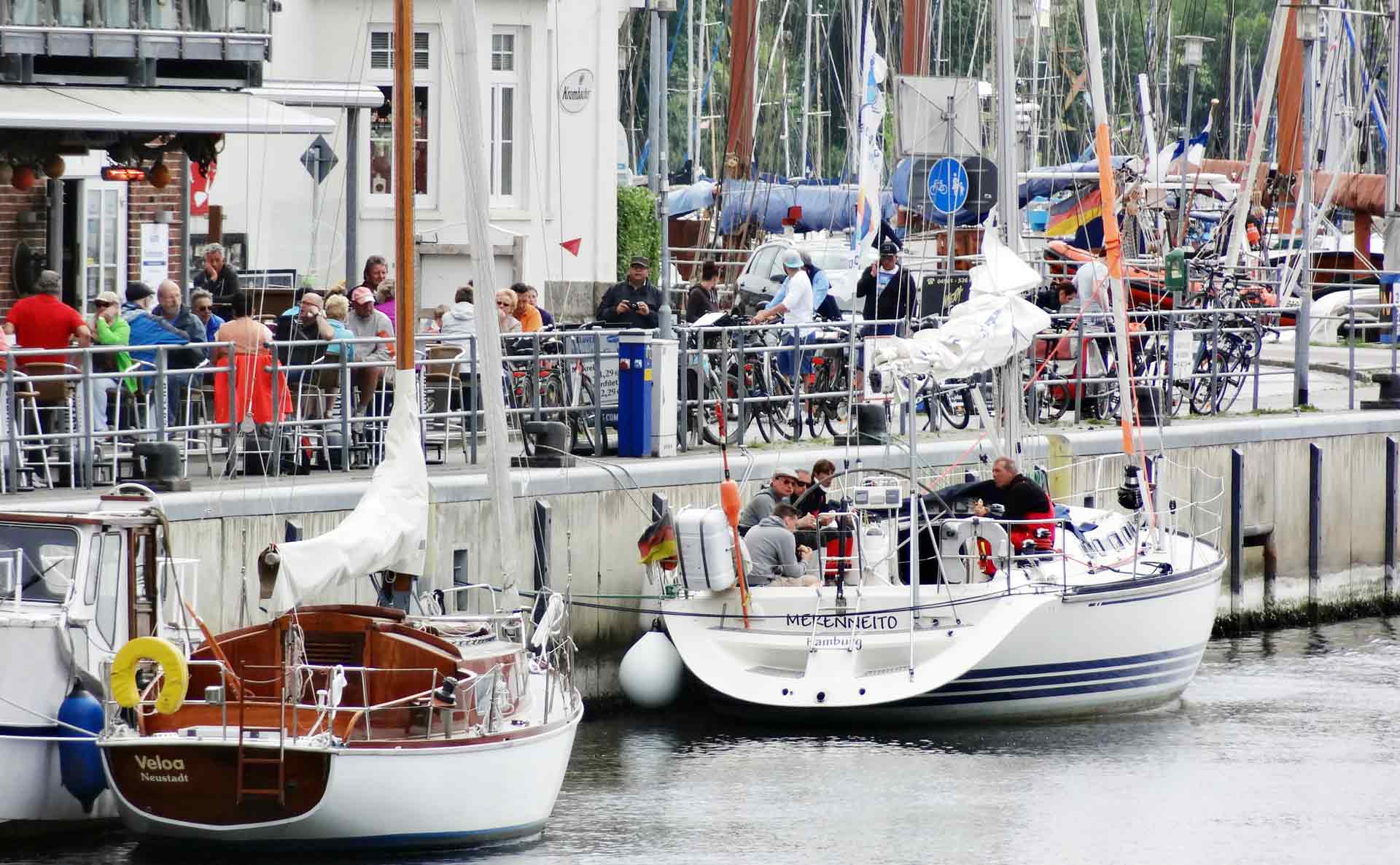
But that was his smallest concern. He wanted to teach us stress-free sailing without yelling or bitching, instead, how to sail in a calm, confident and safe manner. Here are the four big learning I gained during this 6-day sailing school-cruise on an X-442 yacht: The best marina berthing maneuver ever, casting off stress-free, a very quick Figure-8 alternative and last not least the most simplistic last minute maneuver. The best thing: It is possible to do all these maneuvers single-handed.
Marina Berthing a Yacht: The Best Way
We all know the classic landing when it comes to go alongside a pier: Taking aim with the bow, reducing speed as much as we can, move slowly alongside and reverse gear to stop the boat. Now the stress comes into play, because somebody (mostly the wife of the skipper or – worse – an uneducated guest) has to jump to the jetty to head off the boat with a rope. Oh dear, that´s load, there´s a lot of yelling and – perish the thought! – what if wind blows from the “wrong” direction?
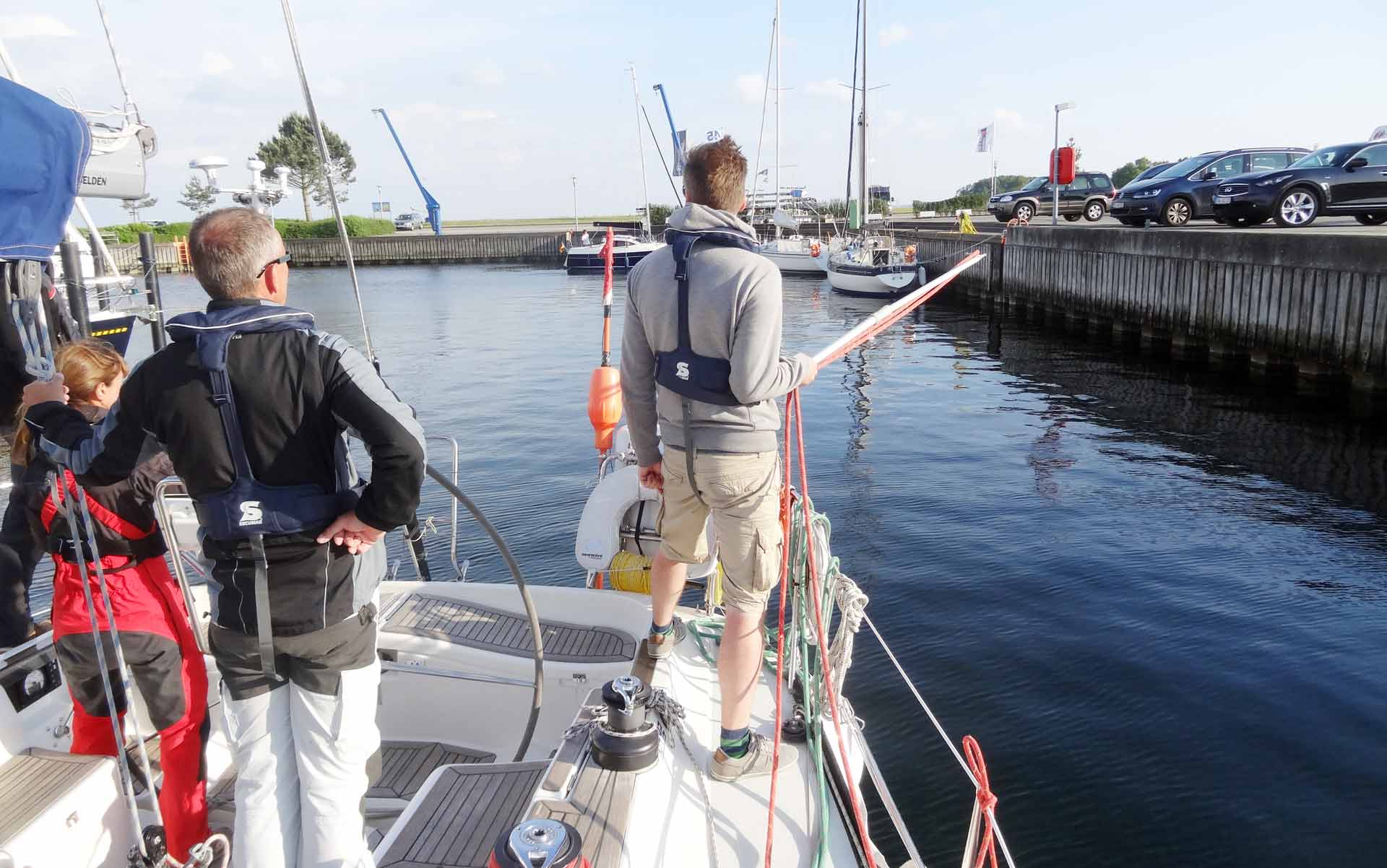
Here´s the problem : Anchor, Bow and pulpit will be put dangerously close to the pier. There´s a whole variety of possible damages lurking. Another problem is, that the skipper will have to be very, very precise at helm and throttle. Which is not a problem for somebody knowing his ship inside out. But who does? When wind blows, drifting will have to be taken into consideration. Last but not least, the view from helming station at the stern to the bow is restricted and often obstructed. If the berthing space is too narrow, a safe landing won´t be possible. Not the best premises, aren´t they?
Well, here´s the solution: You just have to reverse gear. Landing stern ahead is fast, convenient, safe and absolutely stress-free.
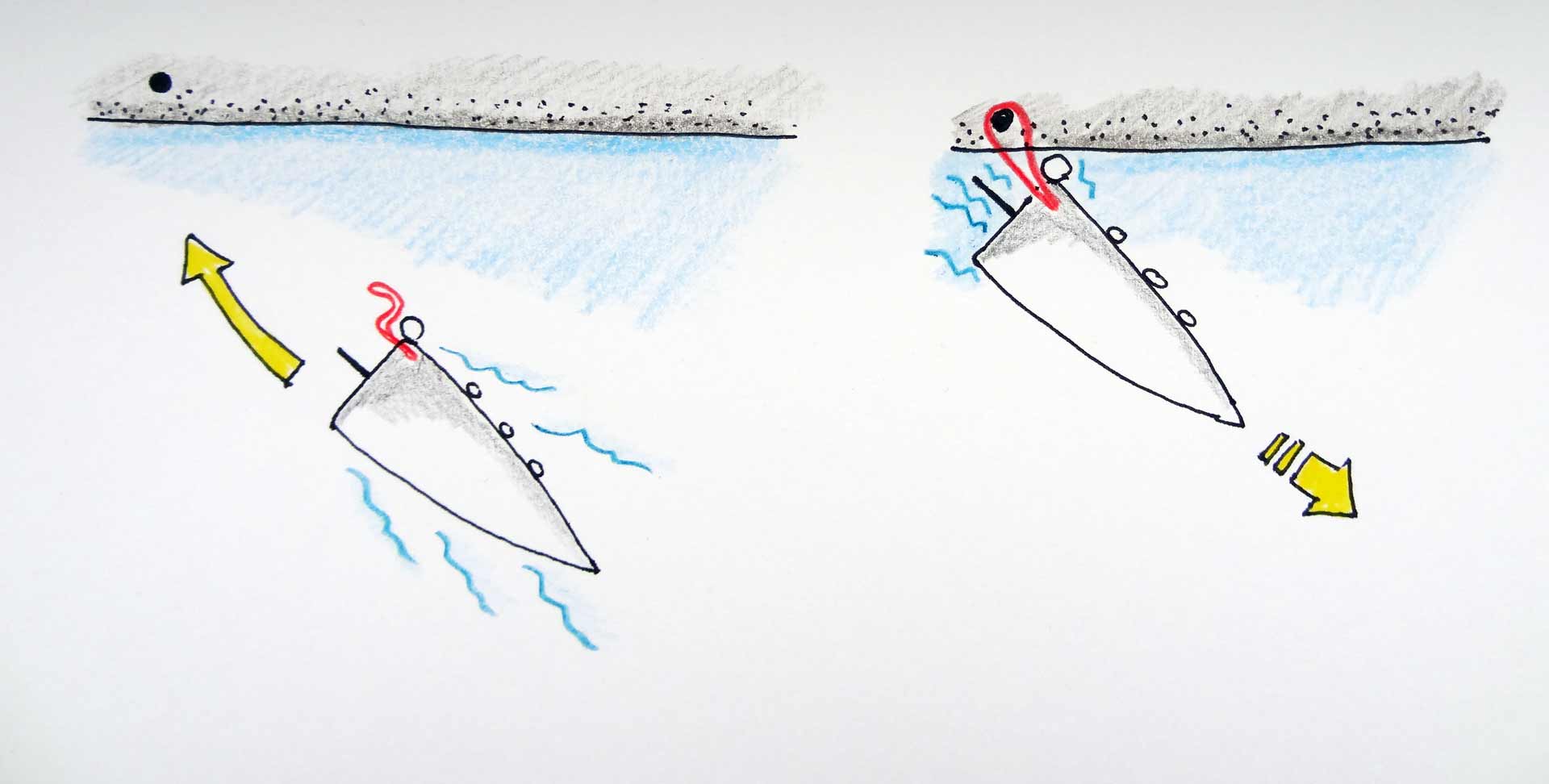
This is how the skipper will perform this maneuver:
- You will steer the yacht in reversing right in front of the harbor entrance . That means go into reverse gear before entering the marina.
- This is by putting her stern into the wind, full throttle reverse to gain momentum and then like a van or a car – steaming through the jetties stern ahead.
- Don´t panic: The ship is just perfect at the rudder. It´s just that you never have had experienced her behaving that way. If you have enough incoming flow to the rudder (1 knot will do) she will obey your helming decisions like if she would go forward. You will instantly notice: Perfect view , no obstructions.
- When steaming through the jetties, your wife or guests may ready the fenders at the very ship´s side you are going to put along the pier. Best thing: You will need just one single rope . No, believe me: Just one single rope!
- This one rope is the stern rope. You will prepare a knuckle , depending on your ship this knuckle should at least measure 2.50 meters.
- Now put the knuckle onto the boat hook and be ready . Either you or one of your guests will later put this knuckle over a bollard or clamp. That´s basically it.
- If you have the bollard in sight where you want to land the boat, bring the ship slowly to that point by steering the pier-side stern right towards the bollard, try to achieve an angle of 25 to 45 degrees (depends on the wind). Do it slowly. Slow! Don´t forget to have a large ball-fender right at the stern.
- When you have half to one boat length to the pier left, put engine in neutral , then slow ahead. Let the boat drift towards the bollard, ready at boat-hook!
- Give one or two short pushes flank ahead to bring her to a stop shortly before the pier side. You will notice that you will be able to stop the boat just centimeters away from the pier – it´s easy.
- If she is stopped, you´ll have some seconds to have the knuckle be put over the bollard .
- When rope is over the bollard, slow ahead and rudder to pier side. Now magic happens: The boat will align herself to the pier side slowly . If she´s parallel to the pier, full helm to pierside and engine still running: The boat will be pushed against the pier side and thus be landed stable.
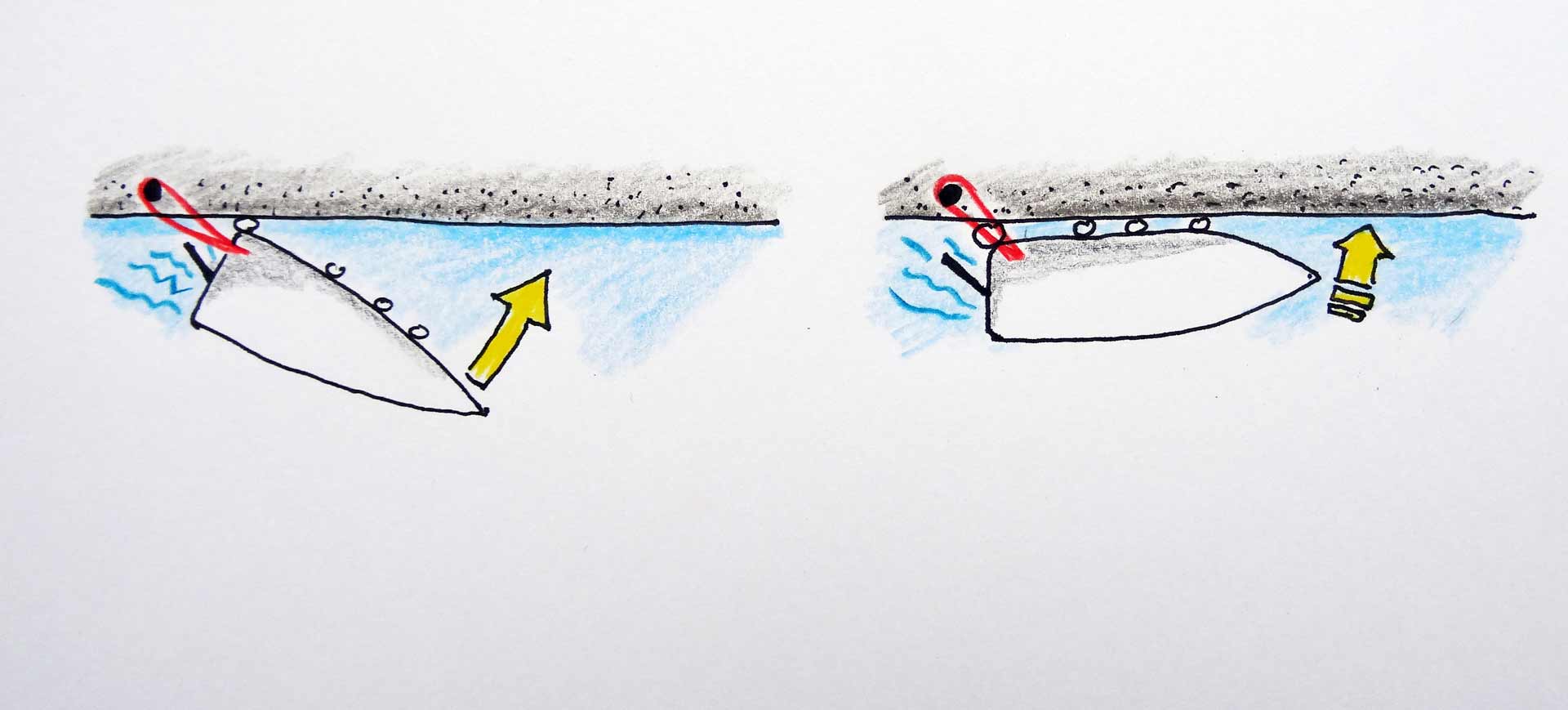
And that´s it. Landing stern ahead with just one rope. You have now all the time in the world to have the rest of the ropes applied accordingly – engine still running holding the ship tight to the pier.
These are the advantages of the maneuver : First of all, it´s totally stress free. Just you at the helm with a splendid view and only one single rope. No jumping to the jetty, no yelling, no hectic. You have a perfect view over the stern, distances are very easily assessable. This maneuver can be done single handed. The best: You can land the boat even into very narrow berths alongside a pier where forward would´nt be possible at all.
If there´s the need to cancel the maneuver, just put ahead gear and you will instantly have flow at the rudder to be able to act quickly in case of emergency. The other way round would take a lot more time since there´s no flow from the screw in reverse so the ship will need a certain speed to answer helm. You want to see how that works? Here´s a video of landing a 44 feet sailing yacht stern ahead with just one single rope :
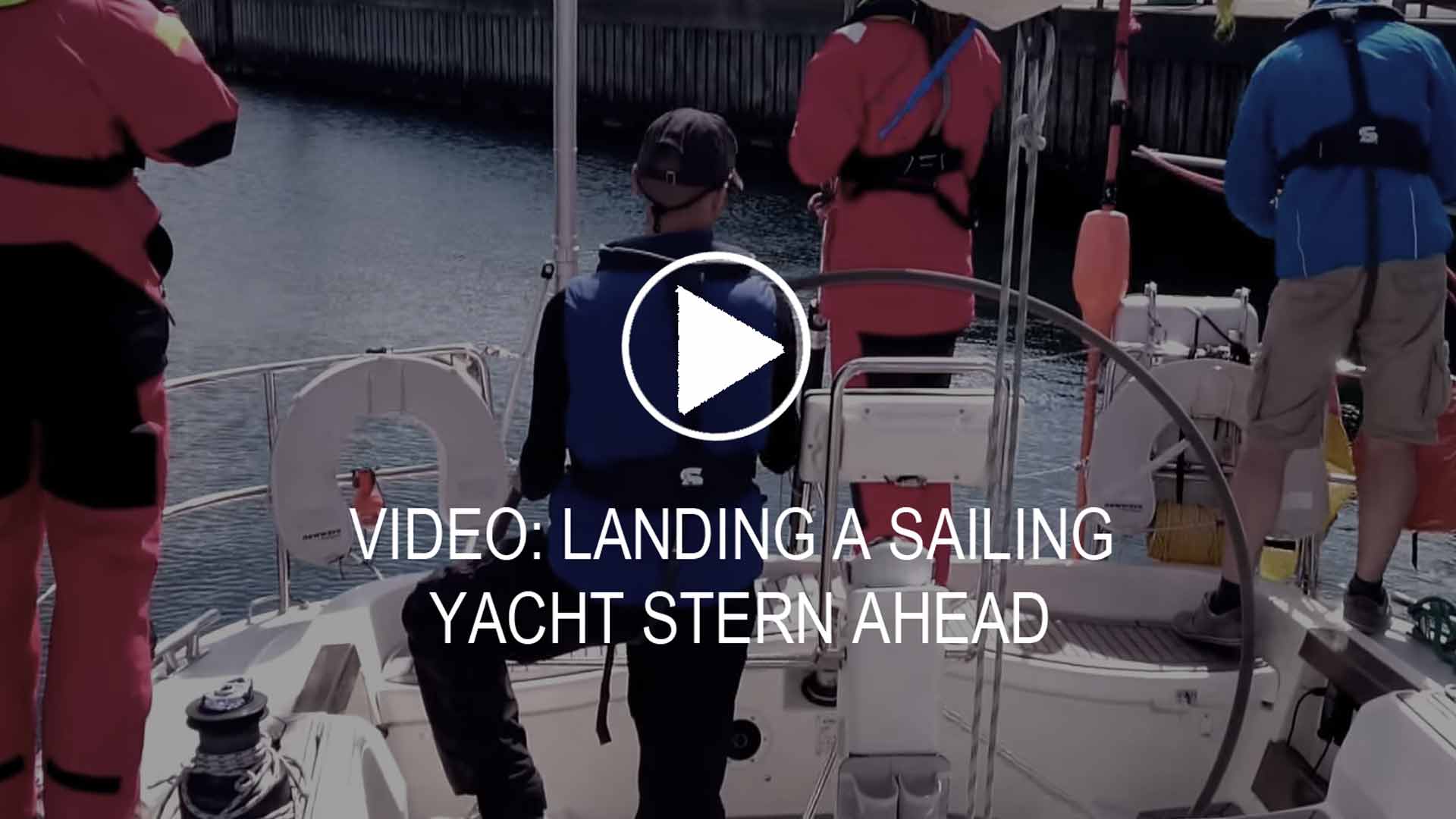
I would say it´s a perfect maneuver for small or inexpert crews. You won´t have to employ a whole armada of people to bring the ship to a standstill. It´s stress free, elegant and perfect for showing off. Landing stern ahead can be done in every wind situation , no matter from where it will blow. By putting the boat in a stable condition with the engine and holding her in position you may take any time you want to apply all ropes and springs ropes.
Caution tiller-steering: Reversing puts enormous forced onto the rudder so you ought to hold very, very tight to the tiller to avoid rudder-damage.
Nevertheless, it´s a perfectly beautiful maneuver. Think of it: I have never had the responsibility for a 44 feet yacht – and I was able to safely land her in a matter of 3 or 4 practicing rounds.
Easiest Way for Casting Off
As well as it is the case for landing, the classic procedure for casting off when alongside a pier is inching into the spring. Of course, you may give the boat a push or just let her drifting away, but there is a much more elegant and convenient way to cast off.
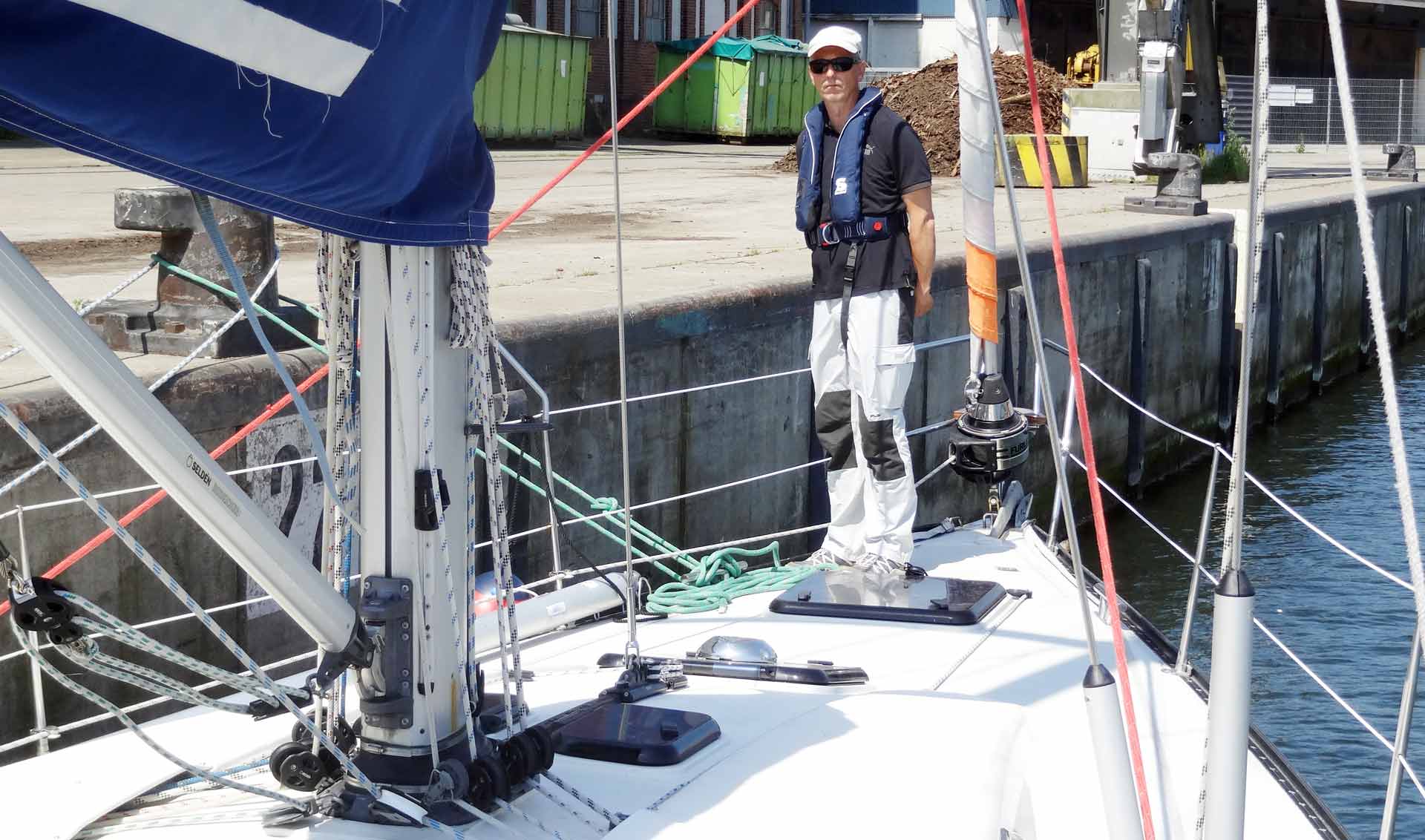
Problem with standard maneuver: Pulpit, anchor or bowsprit could again hit the pier when the stern will be going away from the pier side first. Again, there´s low visibility from stern to bow and not less skippers miscalculated the moment to let loose the spring rope and steam away. If you are sailing alone, the crucial last rope to be put off is at the most remote place from the helm, where you will have to be steering and controlling the engine.

Solution: Let physics do it´s job. We will be casting off like magic (again) with a seaward stern rope. This will enable us to start the cruise bow first, avoid reversing and cast off fast and neat.
This is how the skipper will do it:
- Still moored, you will apply a rope as a knuckle over a bollard and have it directed to the seaward middle clamp.
- Start the engine and – again – hard rudder to pier side to push the ship steady to the pier. Now take in all ropes except the seaward and the stern rope .
- Set engine to neutral for a second, strain on the ropes will ease, take in stern rope. Engine to slow ahead again .
- Now the boat will slowly bear away from the pier side. Again don´t forget to have a large ball fender at the stern. You may control speed of the maneuver by putting helm midship or have more throttle applied.
- If the angle to pier side is enough (again, depending on the local situation and winds) set engine to neutral, easing strain on the seaward rope and take in the seaward rope fast .
- Flank ahead and off you are.
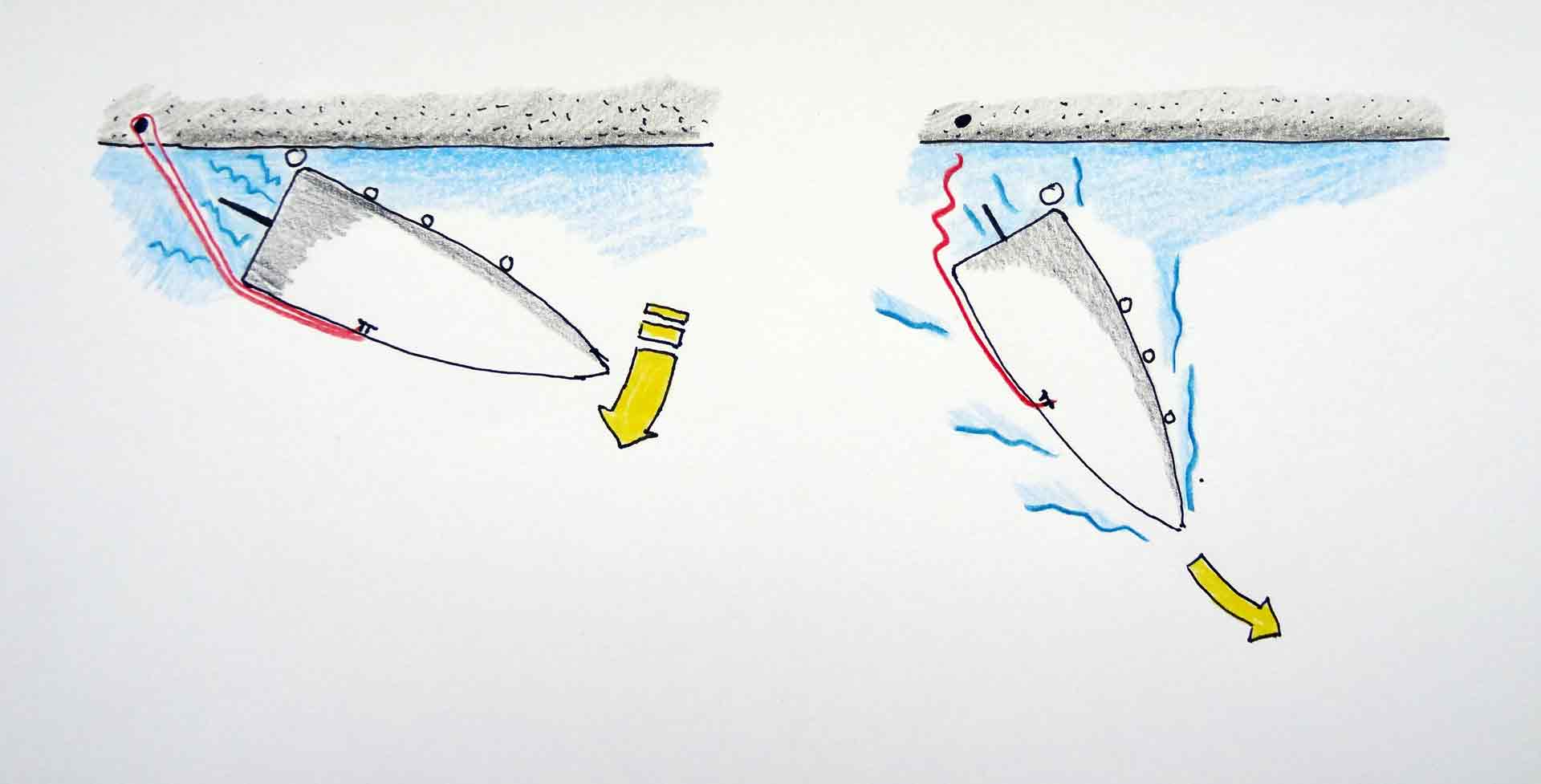
The advantages: This is casting off with a guaranteed success. You will be able to perform this maneuver in any circumstances no matter from where wind will be blowing. You can cast off bow first, adding safety because you have flow at the rudder from the screw at any time. That´s different when casting off stern first. Again, this maneuver could be done single handed (if the clamp for the seaward stern rope is within comfortable reach. There is now hassle with all kinds of ropes since you may take in all (except the stern ropes) before casting off.
Oh, how I loved it to start a day like this!
Fastest MOB-Maneuver: The Quickstop
I love doing the MOB maneuvers since I´ve learned how to perform the Figure-8 . It´s fun to do it because there´s action, work at the winches and you have to be precise at both helming and assessing distances. Though I hope I´ll never be forced to apply my knowledge in real life rather than taking on board a fender again. When doing the Figure-8 I was able to rescue the buoy after 1 to 1.30 minutes. Pretty fast, isn´t it? But there´s even a faster maneuver. The Quickstop.
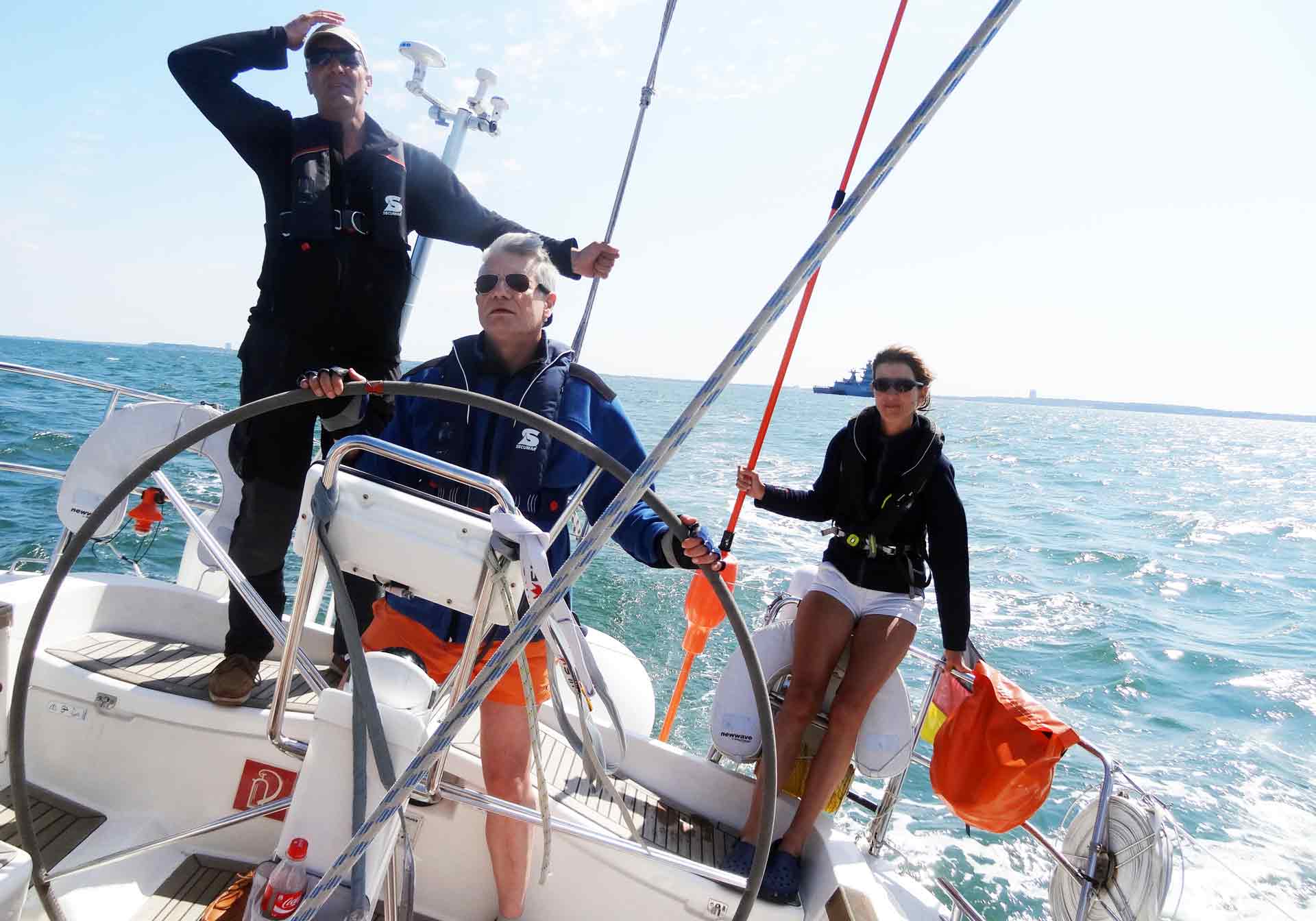
Problem with Figure-8: There might be situations when this all-time classic isn´t the maneuver of first choice. Maybe there´s not enough room, you are alone and have nobody to work the sheets or if something (the weather?) forces you the react very, very quickly.
Solution: The Quickstop will return the yacht to the spot of the MOB within a wink of an eye and without allowing too much distance to be put between you and the person in the water.
This is how you´ll perform the Quickstop:
- A Quickstop should be performed when sailing close hauled.
- When the person is off the ship, try to haul the mainsail – and perform immediately a tack .
- Let the jib be stalled – it will push the bow through the tack faster and further reduce speed of the boat
- Performing a full circle around the MOB, when one or two ship lengths passed the person, further circling to a gybe .
- Immediately let loose the jib-sheet, shortly thereafter the mainsheet.
You should now have performed a full circle, have reduced speed to near zero and be positioned right next to the person to start the recovery efforts.
Advantages: The Quickstop is a very fast maneuver requiring very little space. It can be performed with just one person on board and needs no big preparations (given that the boat is sailing close hauled). On the contrary to the beloved Figure-8 there´s no working at the winches needed. But it´s a maneuver suitably only when sailing close hauled or in a close to beam reach.
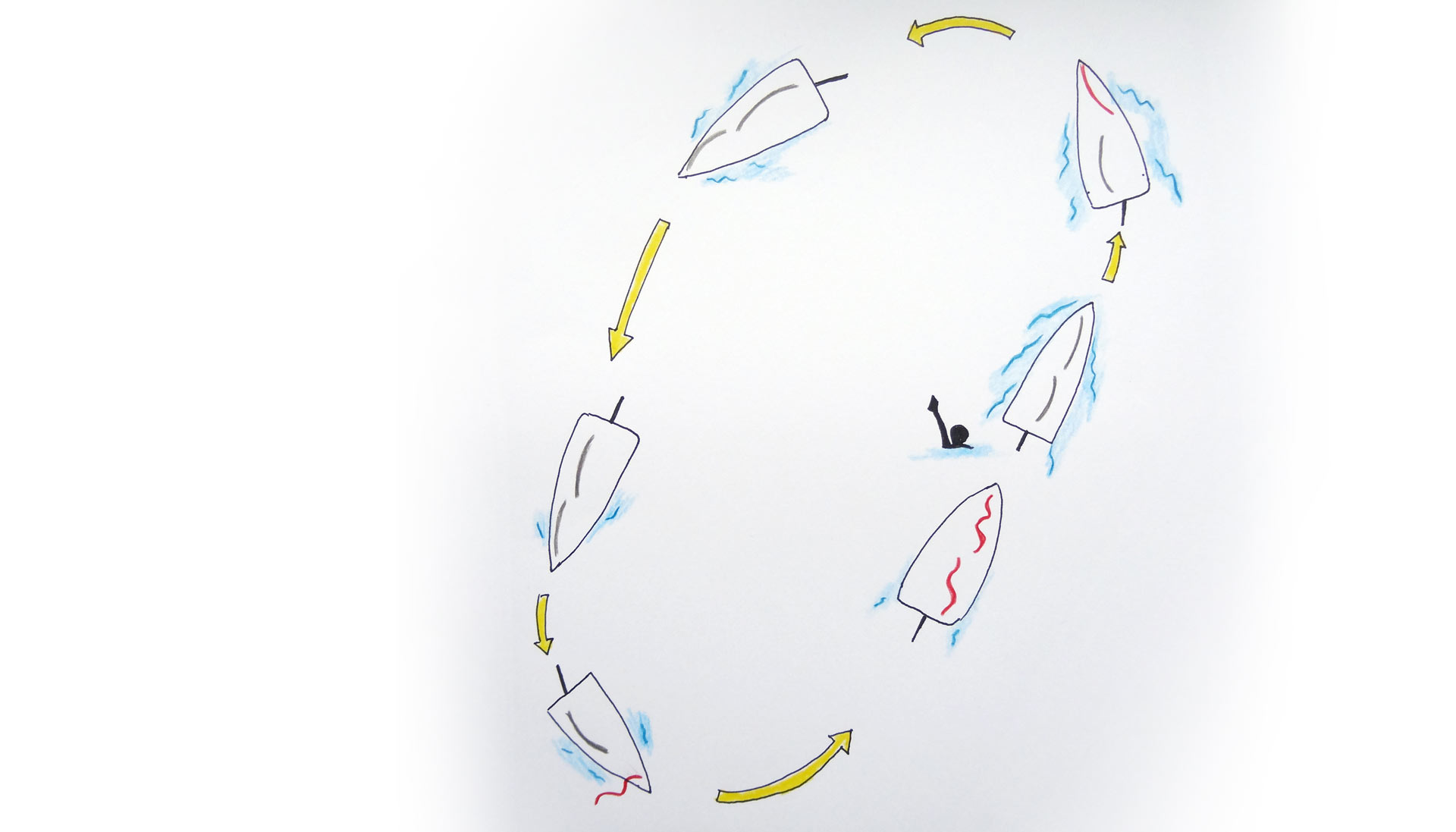
If you ask me personally, I like the Quickstop but I will stick to the Figure-8. Why is that? Because I have more time to plan a precise run towards the MOB. With a Quickstop, there is no such time. I will have to know my boat very intimately to have it stopped right at the desired position. With a Figure-8 I will first put some distance between me and the person to have a perfect run into the wind to the rescue. I really didn´t like performing the Quickstop, I found it was too much of “music” and hectic associated with that maneuver. But that´s surely a question of practice.
And here´s what I think too: With every single cruise you are going to cast off to, there should be at least one MOB-trial for everybody helming the ship. No matter if Figure-8, Quickstop or just simply MOB with engine is practiced.
Last Minute Maneuver: Full Circle under Full Canvas
When two ships are meeting each other in open sea or on waterways, we do have collision prevention rules regulating how everybody ought to act accordingly. Who is the privileged vessel, who will have to change course – it´s a clear set of rules every good seaman should have knowledge of. But there are so many occasions when simply the give-way vessel won´t change course. If signaling won´t do the job, there´s one last thing to do when acting as privileged vessel: Avoid collision with the so-called last minute maneuver.
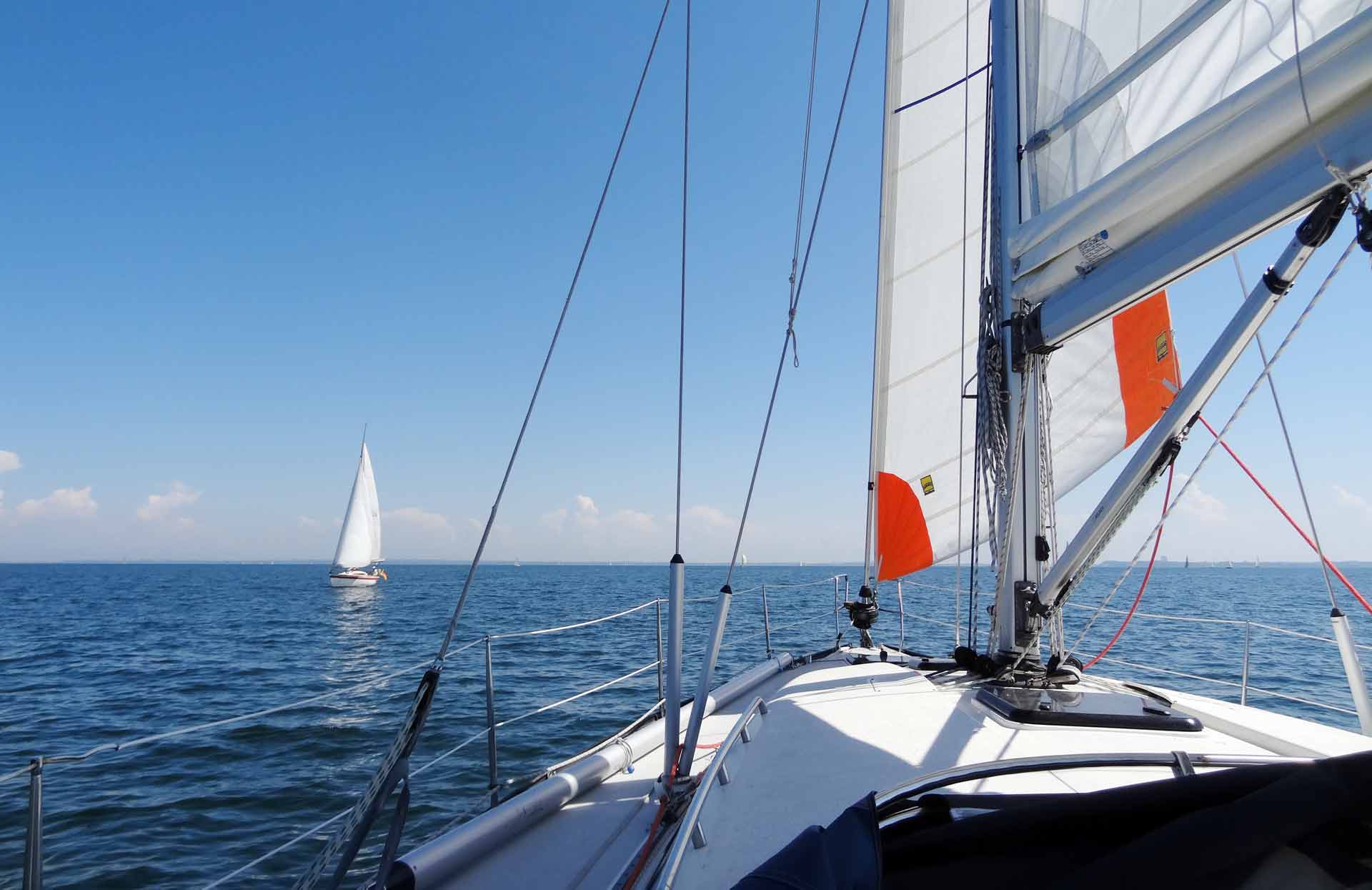
Problem: “High noon” at the sea – big time panic! Especially in cramped waterways. As a skipper a ton of questions and decisions are battering upon our heads. Where to go? Port? Starboard? Luffing, veering off? Skippers can be made unable to cope at an instant. What the hell is this “last minute maneuver”?
Solution: Well, it´s easy as ABC when sailing close hauled or in a close reach. We just need some speed. And a courageous helmsman.
This is how the skipper will act:
- Put helm full rudder (either side) and don´t change anything for the sail trim
- That´s basically all. The boat will perform a full circle, though with reduced speed. During the full circle the give-way vessel will hopefully steam past our collision course when we head back onto the initial course. That´s basically all. And yes: A sailing yacht perfectly can perform a full circle without any sheet-work.
Advantages: This is so simple, I cannot find words. It does perfectly work when sailing close hauled or on a close reach. Yes, there´s some stress in the rigging but that´s far better than having your bow slammed into another vessel. Even during the full circle you will be able to decide to stop circling, veer the sheets to have the yacht sailing at a different point of sail when going back to initial course isn´t desirable anymore.
4 Essential Maneuvers for Skippers
This is what I´ve learned during the 6 days onboard MERENNEITO of Well Sailing Hamburg. 200 miles of perfect sailing with skipper Dietmar and Andrea. It´s a great feeling having passed the SKS-examination by having enjoyed the hard yet perfect drill of skipper Dietmar. He was pushing us, adding a new challenge every day and giving room for trying, being creative and seeking own solutions (even if his solutions proofed superior in the end).
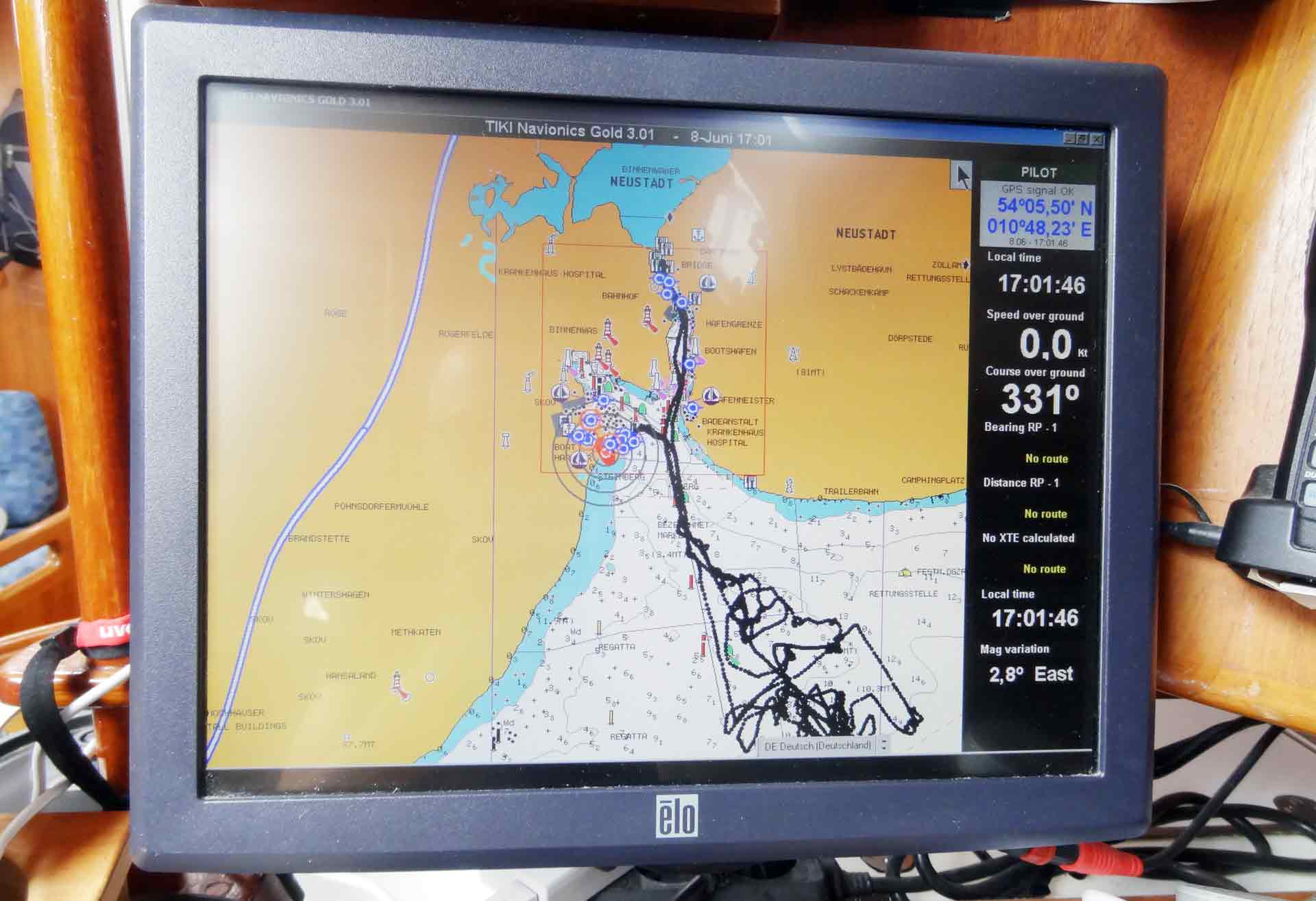
By teaching us how to land, cast off or do a MOB rather different as it may be taught by the book he achieved his goal: Putting a little bit of seamanship into us lubbers and besides, making us pass this exam and get the certification.
I hope one or two of the shown maneuvers are of interest for you.

Boating Basics Online is reader-supported. When you buy via our links, we may earn a commission at no cost to you. Learn more
What Is a Berth on a Boat? – A Simple Explanation
Written by J. Harvey / Fact checked by S. Numbers
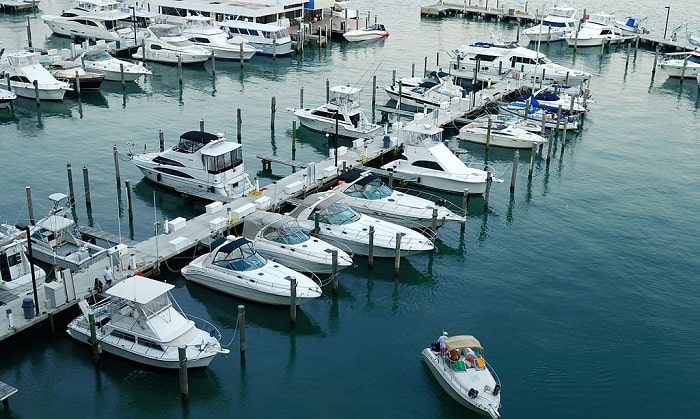
It is essential to know the basic parts of a boat before we get one for our own. What is a berth on a boat, and what should we know about boat berthing?
Berth on a boat often refers to a bed or any area for sleeping, but there is another refers to the mooring. This article will look at this boat part and a different meaning, including what we need to know to avoid any confusion.
Keep reading to learn more.
Table of Contents
1. Sleeping Berth
2. types of sleeping berth, 3. mooring berth, 1. can you sleep comfortably on a boat, 2. how do you properly berth a boat, what is berthing.
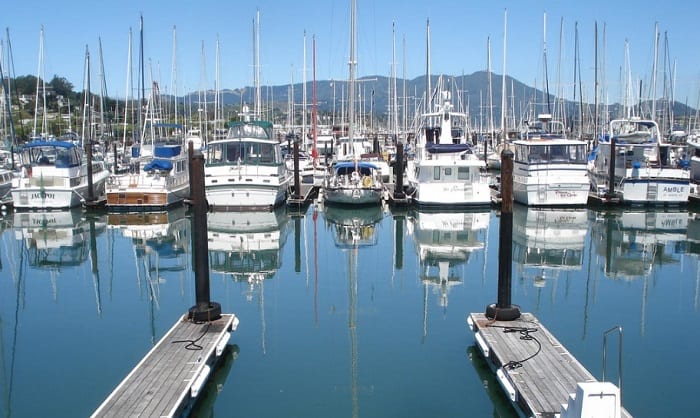
There are two ways of defining boating-related berth, which may lead to some confusion. What is the meaning of berth exactly?
- The first meaning refers to the sleeping or resting area found on a boat. It may be a familiar term to people who frequently travel long distances because this term is also used on other types of vehicles such as trains.
- The other refers to a type of mooring, specifically at a dock or marina.
The best way to avoid confusion when referring to berth is by establishing context. If it’s something on the boat or related to sleeping or rest, it’s the first berth definition and if it’s at the dock or is a place for the ship, it’s the second one.
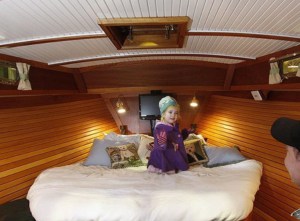
While usually referring to the sleeping area on a vessel, such as a bed or a bunk, it may also mean any space allotted for people staying on a vessel.
The berth on a boat can be one of a few different types, and these relate to their location on a boat. Let’s look at four common types.
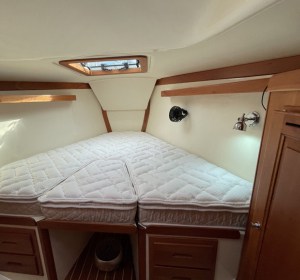
Named because of its location, the v-berth is found at the tip of the hull with the V coming from the bow’s triangular shape. It is not uncommon to have a double berth on a boat in this area that can neatly fold away.
- Settee berth
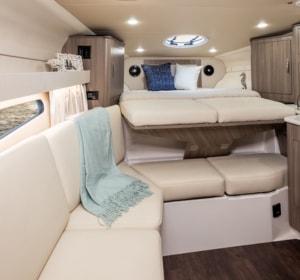
This one converts from a cabin seat, much like a sofa bed. Part of the seat can be folded out, making for a sturdy and spacious bed. It is a considerably comfortable sleeping space because movement in this area is minimal compared to other boat parts.
- Pilot berth
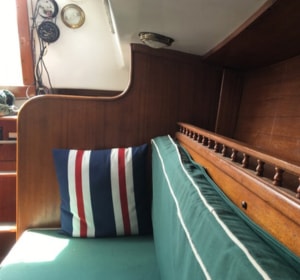
This type is usually walled into the lower section of a boat’s deck and is usually found in larger boats. It was originally intended for a pilot or vessel operator as a backup bed for instances where the situation demanded someone be near the control console at all times. It is an uncomfortable berth due to its constricted space.
- Quarter berth
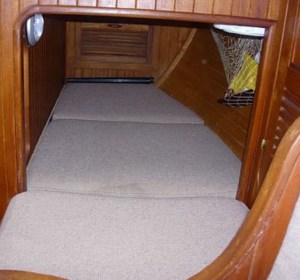
This final one is the type usually found on smaller boats, if they have a berth at all. Located under the cockpit of the boat because a small boat would not have any cabin space to spare.
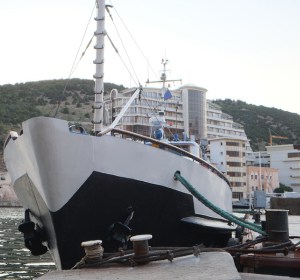
As far as mooring and berthing a boat is concerned, berth refers to the space allotted to an individual vessel at a berthing marina. It is similar to a reserved parking space where the boat can stay for extended periods.
Another name for this is the slip, and they also vary by size to better accommodate the boats they are intended for.
An exception to the above definition is the marina berth, which is instead used to allow passengers on and off boats, but vessels at berth in other areas are usually allowed to stay indefinitely. When used as a verb, to berth means to moor the boat for longer periods, while dock would refer to mooring temporarily.
Bringing ships to berth port can be quite different from smaller vessels because of the numerous considerations involved in operating a ship.
Using tugboats for berthing a ship is standard in situations where the wind and water current makes it difficult for a ship to maintain stability on the water.
Frequently Asked Questions
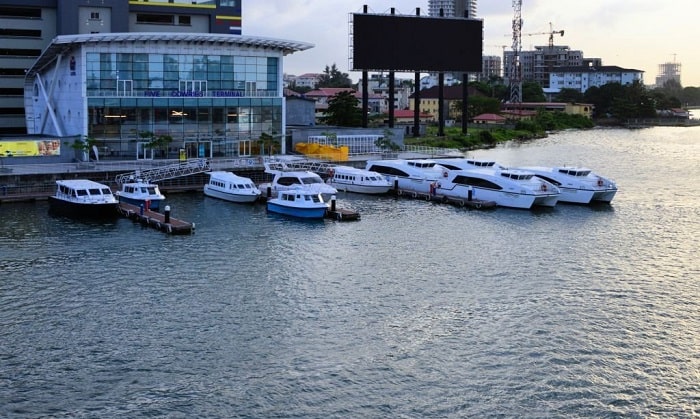
It depends on how much movement is on a boat, and the amount of movement perceived may change depending on where you are on board. Knowing how to position yourself in a berth makes a difference.
For example, in a v-berth, it is best to sleep in a position where your feet are closest to the bow. This allows you to reduce shaking your head as well as the risk of hitting your head against the wall in the narrow space of the bow.
The proper procedure involves entering the slip carefully while mindful of the wind and current. Remember that there is only a small amount of extra space in a slip, so it is essential to bring in a boat slowly. Be sure to prepare your lines and fenders before making your approach.
Now you know that berth can refer to two different things; the resting area on a boat or a place to moor the boat for long periods. You also have some familiarity with types of berthing.
Should you find anyone asking, “what is a berth on a boat?”, don’t hesitate to share what you’ve learned.
Remember to boat safely.

“My intention from the first day establishing Boating Basics Online is to provide as much help as possible for boaters who want to experience a first safe and convenient trip. So feel free to join us and share your beautiful journeys to the sea!”
What Are Berths on a Boat: A Comprehensive Guide
by Emma Sullivan | Aug 21, 2023 | Sailboat Gear and Equipment

Short answer: What are berths on a boat?
Berths on a boat refer to sleeping spaces or beds for crew members or passengers. These are usually found in cabins and can be fixed bunks, foldable beds, or convertible seating areas. Berths provide individuals with a place to rest comfortably while aboard a boat or ship.
Understanding Berths on a Boat: An Essential Guide for Beginners
Are you new to the world of boating? Do you find yourself confused when it comes to understanding berths on a boat? Fret not, for we have got you covered! In this comprehensive guide, we will delve into the nitty-gritty details of berths and equip you with all the knowledge you need to become a seasoned sailor.
First things first, what exactly is a berth? In the context of boating, a berth refers to a sleeping or resting area on board. Think of it as your cozy corner amidst the vast expanse of water. The key aspect of berths is that they are designed to offer comfort and convenience while accommodating the crew or passengers overnight or during long voyages.
Now that we have defined what a berth is, let’s explore different types commonly found on boats . The most popular ones include V-berth, Pullman berth, Pilot berth, Quarterberth, Settee berth, and Bunk bed-style berths. Each type offers unique features and advantages depending on the size and layout of the boat:
1. V-berth: This type takes its name from its shape resembling the letter “V” at the bow (front) of the boat. It is considered one of the most comfortable berths due to its spaciousness and easy access.
2. Pullman berth: Known for its versatility and functionality, this type can be pulled out from beneath another piece of furniture like a settee or table when needed.
3. Pilot berth: Found near navigation stations or in small cabins often utilized by crew members during night shifts; pilot berths are space-saving solutions for accommodating additional sleepers onboard.
4. Quarterberth: Positioned aft (rear) near the cockpit area; quarterberths maximize available space by utilizing areas that might otherwise be unused.
5. Settee berth: Located in the main salon, settee berths are converted from seating areas using cushions. They provide a comfortable resting spot during the night and revert back to seating during the day.
6. Bunk bed-style berths: Often found on larger boats or yachts, these berths feature stacked beds, typically with small storage compartments for each occupant.
Now that you’re acquainted with different types of berths, it’s essential to consider some practical aspects before deciding which one is best suited for your needs:
1. Size: Berth sizes vary across different boats, so ensure you choose one that allows you to stretch out comfortably.
2. Accessibility: Consider how easy it is to get in and out of the berth. Some may have low ceilings or require climbing over others.
3. Ventilation and Lights: Look for berths that offer ample airflow and natural light sources, such as windows or portholes – ensuring a more pleasant sleeping environment.
4. Privacy: Depending on your preferences, check if the berth provides curtains or dividers for privacy when sharing a cabin with others.
5. Storage Space: Assess whether there is enough storage space under or around the berth for your personal belongings and necessities.
By understanding these factors, you can make an informed decision regarding which type of berth will enhance your boating experience to its fullest potential.
In conclusion, mastering the art of understanding berths on a boat is crucial for every beginner who wishes to embark on exciting maritime adventures. From enjoying peaceful nights under starry skies to rejuvenating amidst the gentle rocking of waves; choosing the perfect berth will significantly contribute to your overall comfort and enjoyment at sea. So hop aboard, armed with this essential guide and revel in unforgettable experiences as you navigate through waters while reclined in your very own floating sanctuary!
Exploring the Design and Types of Berths on a Boat
Title: Perfecting the Art of Nautical Slumber: Unveiling the Secrets Behind Boat Berth Designs
Introduction:
In the realm of boating, few things are as rewarding and essential as a good night’s sleep. To ensure optimal comfort and restfulness, it is crucial to understand the nuanced design and various types of berths found on boats . From the luxurious quarters aboard a superyacht to the humble bunk beds on sailing vessels, this blog will delve into every aspect, providing you with an in-depth exploration of berth designs and their functionalities.
1. The Basic Anatomy of a Berth:
Let’s start by dissecting a typical berth to better comprehend its design intricacies. A berth generally comprises three main components: the mattress or sleeping surface, the surrounding structure (often referred to as “coamings”), and potential storage options underneath or around it.
2. V-Berth:
One of the most common types of boat berths is the venerable V-berth . Commonly found in sailboats or motor yachts with bow cabins, V-berths utilize their triangular shape effectively to maximize space utilization while providing comfortable sleeping arrangements for two individuals. Additionally, many V-berths offer built-in storage compartments beneath them, making them ideal for stowing away essential items.
3. Quarter Berth:
As we move towards exploring midship cabins in smaller boats or aft cabins in larger vessels, we encounter quarter berths — compact yet efficient sleeping spaces tucked into corners near navigational areas or engine compartments. Although limited in size, clever designers often equip these berths with folding mechanisms to transform them into seating areas during daytime use.
4. Convertible Settee Berth:
A favorite among boat owners who cherish flexibility in their onboard living spaces is the convertible settee berth. This innovative design combines cozy seating during daylight hours with easily convertibility into a snug bed at nightfall. By utilizing folding mechanisms or removable cushions, these berths strike a balance between comfort and multi-functionality.
5. Pilot Berth:
A staple on larger sailboats, the pilot berth melds practicality with a touch of seafaring charm. These compact berths are typically found near the galley or navigation station. Designed for single occupancy, their unique feature is detachable lee cloths – fabric barriers that prevent occupants from being accidentally tossed out during rough seas – ensuring a good night’s rest even in challenging conditions.
6. Bunk Berth:
When it comes to optimizing space in shared cabins, bunk berths often take center stage. Frequently seen in crew quarters or children’s cabins, these vertically stacked beds offer privacy and functionality without compromising on comfort. Ladder access and sturdy safety rails guarantee ease of use while sailing through those unpredictable waves.
Conclusion:
Understanding the design and types of boat berths opens up a world of possibilities for creating comfortable sleeping arrangements aboard vessels large and small . Each style offers its own unique advantages, catering to different needs and preferences of boaters worldwide.
Whether you’re lounging in the luxurious V-berth on a superyacht or cozied up in a convertible settee nestled against panoramic windows, one thing remains constant: crafting the perfect berth design ensures peaceful slumber amidst nature’s gentle rocking onboard your beloved vessel.
Step-by-Step: How to Prepare and Arrange Berths on Your Boat
Are you eager to set sail on your boat, but find yourself clueless about how to properly prepare and arrange the berths? No worries, fellow sea enthusiasts! In this detailed guide, we will walk you through each step of the process, ensuring that your berths are not only organized but comfortable too. So grab a pencil and paper because by the end of this read, you’ll be ready to turn your boat into a cozy floating haven.
Step 1: Assess Your Space
The first rule of thumb when preparing and arranging berths is understanding the space available. Take a thorough look at your boat’s interior and evaluate how many berths it can comfortably accommodate. Consider factors such as size, shape, and width to determine the number of berths your vessel can handle. Remember, it’s always better to prioritize comfort over cramming as many people as possible onto your boat.
Step 2: Ensure Safety First
Before diving into creating a dreamy berth setup, prioritize safety for everyone onboard. Make sure each berth has sturdy handholds nearby or overhead in case of rough waters. Install guardrails or nettings along open edges to prevent accidental falls during sleep or sudden movements. Additionally, invest in high-quality bed frames and secure them properly to avoid any unwanted surprises while sailing.
Step 3: Optimize Storage Solutions
Now that safety is taken care of let’s move on to optimizing storage solutions! We all know that boats have limited space; hence utilizing every nook and cranny becomes imperative. Look for built-in drawers beneath the berths for storing personal belongings or install multi-purpose furniture like beds with hidden compartments below. This way, you’re maximizing storage without compromising on comfort or aesthetics.
Step 4: Mattresses Matter
Comfort is key when it comes to creating perfect berths! Invest in high-density foam mattresses that provide adequate support for a good night’s sleep. Opt for designs that are durable and resistant to moisture, as boats tend to have higher humidity levels. Consider customizing mattresses with waterproof covers or choosing anti-microbial options to prevent any unwelcome mold build-up.
Step 5: Cozy Up with Bedding
Now comes the fun part – adding a touch of coziness! Choose bedding that complements your boat’s interior while maintaining functionality. Opt for machine-washable cotton sheets, which are breathable and easy to maintain during extended trips at sea. Throw in some decorative pillows and snug blankets to create an inviting atmosphere where sailors can unwind after a day on the water.
Step 6: Don’t Forget Privacy
Privacy is crucial when sharing tight spaces. Install curtains or blinds around each berth area to offer individuals their own personal space whenever needed. This not only enhances privacy but also contributes to sound sleep by blocking out unwanted light or noise disturbances.
Step 7: Lighting Makes a Difference
Ambiance matters even on the high seas! Install dimmable LED lights near each berth, enabling occupants to adjust brightness according to their preferences. Soft lighting helps promote relaxation and ensures a tranquil environment for those trying to catch some well-deserved Zs after a day navigating the waves.
Step 8: Add Personal Touches
Last but not least, don’t forget to personalize your boat’s berths ! Hang photos of memorable sailing adventures or display handmade crafts that reflect your seafaring spirit. By infusing your unique personality into these small areas, you add character and make sailors feel right at home during lengthy voyages.
There you have it – your comprehensive guide on preparing and arranging berths on your boat. By following these steps with precision, you’ll transform your vessel into an oasis of comfort where everyone aboard can relax and rejuvenate. Now hoist those sails and embark on unforgettable journeys with berths that are equal parts practical and inviting!
Frequently Asked Questions About Berths on a Boat: Answering Your Queries
Are you considering a boating adventure and curious about the sleeping arrangements on board? We understand that questions may arise when it comes to berths – those cozy sleeping spaces where boaters rest and rejuvenate during their journeys. So, let’s address some common queries and provide you with in-depth answers to help you set sail with confidence.
1. What is a berth?
A berth, in a nautical context, is simply a designated sleeping area on a boat. It’s like your own personal sanctuary where you can unwind after an exciting day of exploring the waters. Depending on the boat’s size and design, berths can range from basic bunks to luxurious cabins equipped with all necessary amenities.
2. How many berths does a boat have?
The number of berths on a boat varies significantly depending on the vessel’s size and purpose. Smaller boats often have one or two simple berths, suitable for short trips or day sails. In contrast, larger yachts can boast multiple cabins accommodating several people comfortably for extended periods at sea.
3. Are berths comfortable?
Yes, absolutely! While smaller boats tend to offer modest sleeping quarters due to space limitations, boat manufacturers strive to maximize comfort within these constraints. Think plush mattresses, cozy bedding, and clever storage solutions to make your berth as comfortable as possible without compromising functionality.
4. Can I customize my berth?
You bet! Many boat owners choose to personalize their berths according to their preferences. From decorative touches such as curtains or personalized bedding sets to practical additions like reading lights or storage pockets – customization options are plentiful!
5. Can two people sleep comfortably in one berth?
Sharing a berth largely depends on its size and configuration, as well as your personal comfort levels with your companion(s). While spacious double beds are available on more substantial vessels, some boats utilize convertible seating spaces to create additional sleeping areas. These may require a bit of creativity, as they can be cozy but still cozy enough for a restful night’s sleep.
6. Do I need my own bedding?
In most cases, boat owners or charter companies provide bedding for each berth. However, it’s always a good idea to double-check beforehand and consider your personal comfort preferences. Packing a favorite pillowcase or lightweight blanket might add an extra touch of familiarity during your nautical slumber.
7. What if I get seasick in my berth?
For those susceptible to seasickness, the motion of the boat can present challenges when trying to rest in any berth. However, some berths are designed with stabilizers or situated in locations that minimize motion, making them more suitable for individuals prone to queasiness. Additionally, over-the-counter remedies or natural alternatives like ginger can help alleviate these symptoms and allow for more peaceful sleep on board.
8. Can I use my electronic devices in my berth?
Absolutely! Many modern boats offer electrical outlets within reach of the berths so you can keep your devices charged and utilize them for entertainment or communication purposes while resting. Just remember, it’s wise to bring along voltage converters or adapters if necessary, as power availability might differ depending on the boat ‘s location.
Once you’re armed with knowledge about berths on boats, you’ll feel confident and prepared for your upcoming boating expedition! Whether it’s a solo adventure or shared with others, these sleeping spaces will ensure you wake up every day feeling refreshed and ready to seize all the wonders that await out at sea.
The Importance of Comfortable and Functional Berths on a Boat
When it comes to sailing the high seas, there are a few essential elements that can make or break the experience. While many might focus on the navigation equipment, the safety gear, or even the aesthetics of a boat, one often overlooked factor is the berths – those cozy sleeping spaces tucked away below deck. However, anyone who has spent a night on an uncomfortable and cramped berth can attest to their importance. In this blog post, we will explore why having comfortable and functional berths on a boat is crucial for an enjoyable and restful journey.
1. THE NEED FOR COMFORT:
Imagine spending hours battling rough waves or adjusting against powerful winds only to retire to an uncomfortable bunk at night. A poorly designed berth not only compromises sleep quality but also impacts overall well-being during extended trips at sea. Comfort plays a significant role in ensuring crew members can relax and recharge after a long day of sailing.
2. OPTIMIZING SPACE:
Space optimization is vital on any vessel, especially when it comes to berths. Sleeping quarters need to provide enough room for individuals to move around comfortably without feeling confined or claustrophobic. Clever design solutions, such as utilizing foldable bedding systems or incorporating storage compartments within berths themselves, allow for better space utilization while maintaining functionality.
3. MAXIMIZING FUNCTIONALITY:
A functional berth goes beyond just providing adequate sleeping space; it should also accommodate other activities that may take place in the cabin area. For example, a well-designed berth might incorporate reading lights, USB charging ports, or handy shelves for personal belongings like books and water bottles. By catering to various needs in an efficient manner, functional berths enhance overall onboard experience .
4. ERGONOMIC SUPPORT:
Sailing puts unique physical demands on our bodies due to constant movement and shifting dynamics aboard a boat. The right ergonomic support provided by properly designed berths helps reduce strain on muscles and joints, improving crew member comfort and preventing potential injuries. Features like memory foam mattresses or adjustable bedding systems can offer optimal support regardless of the sea conditions .
5. PERSONALIZED RETREATS:
In a shared space like a boat, having comfortable berths that allow individuals to retreat and find their own personal oasis is invaluable. Whether it’s for moments of solitude, catching up on some leisure reading, or simply getting some well-deserved rest, comfortable berths provide crew members with privacy and a sense of personal space amidst the communal living environment at sea.
6. INCREASING EFFICIENCY:
Lastly, having well-designed berths contributes to overall efficiency onboard. Individuals who have enjoyed a good night’s sleep are more alert and focused during their shifts, enhancing teamwork and reducing the risk of accidents caused by fatigue. By investing in comfortable sleeping arrangements, boat owners not only prioritize crew welfare but also promote a safer sailing experience .
In conclusion, the importance of comfortable and functional berths on a boat cannot be overstated. From ensuring proper rest to optimizing space utilization, providing ergonomic support to creating personalized retreats— every aspect plays its part in enhancing the overall boating experience for both recreational sailors and professional crews alike. So next time you embark on an adventure at sea or set sail on a long voyage, make sure your berths meet these essential criteria for an unforgettable journey filled with comfort and relaxation.
Expert Tips and Tricks for Optimizing Space in your Boat’s Berthing Areas
Welcome aboard, boat enthusiasts! Today, we embark on a voyage filled with expert tips and tricks to help you optimize the space in your beloved boat’s berthing areas. We understand that a cramped and cluttered living space can dampen the joy of sailing, so let’s get down to business and explore innovative ways to make every inch count.
1. Embrace Multi-functional Furniture: With limited space at hand, selecting furniture that serves multiple purposes is essential. Look for clever solutions such as foldable tables or chairs that can double as storage units when not in use. This way, you’ll have an extra berth or seating area without compromising on convenience.
2. Vertical Storage Solutions: When horizontal space is scarce, it’s time to think vertically! Install shelves or utilize wall-mounted organizers to maximize storage capacity while keeping belongings within reach. Hanging pockets or nets on cabin walls can be ideal for storing smaller items like books, sunglasses, or even refreshments.
3. Creative Cabinetry: Custom-built cabinets specifically designed for boat interiors can be a game-changer. These customized marvels are crafted to fit seamlessly into the nooks and crannies of your berthing areas, unlocking hidden storage potential beneath benches and under beds. Embrace sliding drawers or pull-out racks that make accessing items effortless while maintaining tidiness.
4. Optimize Under-Berth Space: The often-neglected area beneath berths holds tremendous untapped potential for storage optimization. Consider investing in durable and stackable plastic containers that fit neatly under the bed frames for stowing away clothes, extra bedding, or recreational equipment such as snorkels or fishing gear .
5. Utilize Wall Space: Don’t overlook the open wall spaces around your berths; they are brimming with possibilities! Hang hooks near your bedside to conveniently store hats, jackets, towels, or other frequently used items. You could also attach magnetic strips along cabin walls for easy access to metal tools, knives, or spice jars. These simple additions free up drawer space for other essentials.
6. Compact Appliances: When it comes to optimizing space on a boat, downsized appliances are your friends. Explore compact versions of essential appliances like mini-fridges, efficient stovetops with built-in cutting boards, or even washers and dryers specifically designed for marine environments. These space-savers ensure you have all the comforts without sacrificing valuable square footage.
7. Foldable Furniture Magic: Foldable furniture pieces can be godsends in cramped quarters! Consider investing in collapsible chairs and tables that can be easily stored away when not in use. This ingenious trick allows you to open up additional floor space for activities or impromptu dance parties while at sea.
8. Organization is Key: The key to maximizing any space is the mantra of organization – keep everything shipshape! Utilize storage bins or boxes with labels to categorize items and create a systematic approach to finding what you need swiftly. Clever organizers such as hanging shoe holders can be repurposed as convenient storage pockets for toiletries, stationery, or small electronics near your sleeping area.
9. Decorative Mirrors illusion: Strategically placed mirrors have an incredible ability to make interiors appear more spacious than they actually are. Consider installing a well-positioned mirror near berths to create an illusion of depth and openness within confined spaces; this clever hack adds a touch of elegance while expanding visual dimensions.
10. Bags within Bags: Packing efficiently is crucial when optimizing berthing areas. Invest in travel compression bags that allow you to condense clothing items by removing excess air before stowing them away under beds or benches. Additionally, use smaller bags inside larger ones – think nesting dolls – ensuring every inch is utilized effectively.
With these expert tips and tricks in your boating arsenal, you’ll master the art of optimizing space within your boat’s berthing areas. Get creative, embrace functional versatility, and make your boat a haven of comfort where every voyage is a celebration of smart design and organized living! Bon voyage!
Recent Posts

- Sailboat Gear and Equipment
- Sailboat Lifestyle
- Sailboat Maintenance
- Sailboat Racing
- Sailboat Tips and Tricks
- Sailboat Types
- Sailing Adventures
- Sailing Destinations
- Sailing Safety
- Sailing Techniques

- FISHING , INFLATABLE BOATS AND RIBS , MAXI RIBS & LUXURY OPEN CRUISERS , MOTOR BOATS , News , Ports and marinas , SAILBOATS
Choosing a berth
- April 3, 2019
All types of berths
Choosing a berth is a topical thought. Never as now, in the light of the recent extraordinary weather events, the issue of boat safety at ports, once taken for granted, has become a primary concern in the mind of boat owners, overshadowing other aspects such as comfort, costs and services.
The question therefore is: which berths are safer and which ones should I choose?
Of course, there’s no universal or unequivocal answer to this question; however, we can help you make a more conscious choice with the illustration of the different types of berths available in the ports, the explanation of mooring methods and some tips.
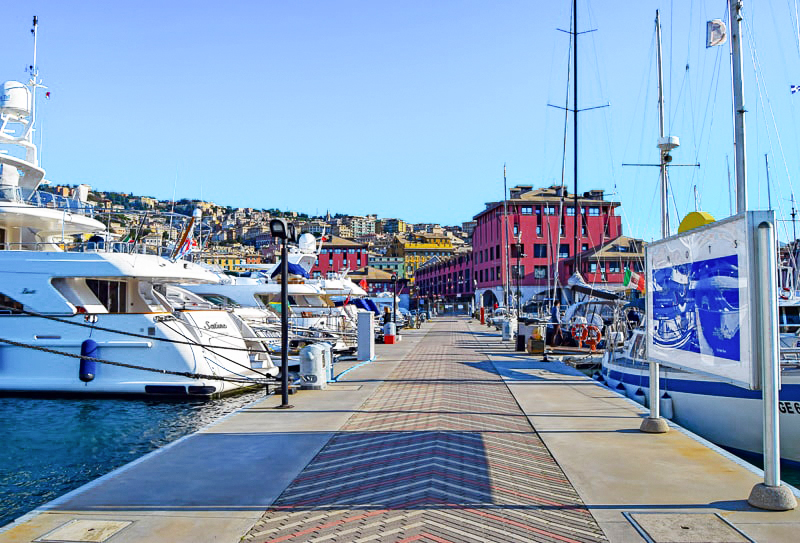
The traditional options offered by ports are represented by berths located alongside a quay. Quays can have sheet pile sections or be floating.
The first are characterized by fixed reinforced concrete support pillars, whose basis, firmly buried in the seabed, develops vertically and supports the walkway alongside which boats will be moored.
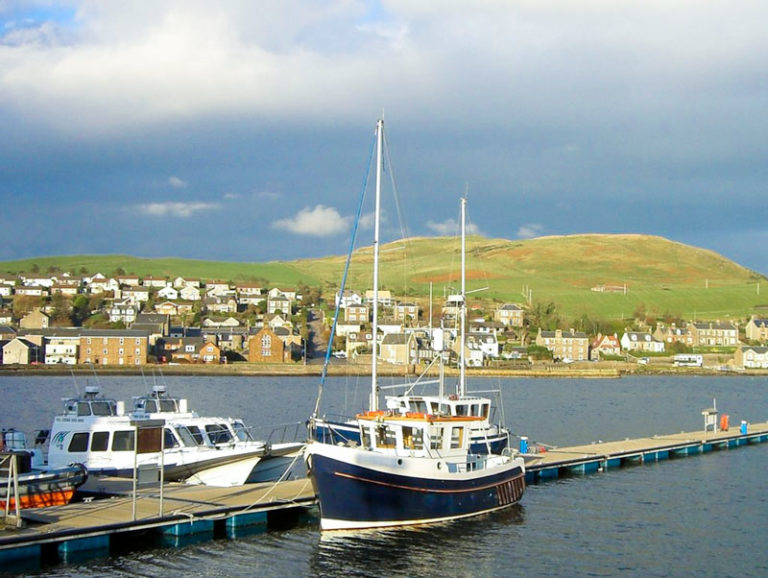
This option is not only the most solid one but also enables big vessels to moor alongside a quay without any problems.
Floating quays, instead, are platforms that float on the water surface. They are held in position by a group of chains fixed to the seabed that should be proportionate to the load of the boats that will dock there. They can be practically installed everywhere because they require no installations on the seabed and, sometimes, are even directly connected to the ground by a walkway. This solution is usually preferred by small and medium-sized boats while bigger vessels often need additional mooring posts in order not to overload the floating structure.

The first are usually used within natural ports without artificial structures. There, boats use a group of relieving ropes secured to concrete blocks that serve as an anchor; this way, bows can follow the natural wind direction. These berths are accessible by land only if you have a means that guarantees transshipment.
Berths alongside dolphins are typical of ports that suffer important tidal ranges, such as the Venice lagoon. Dolphins, arranged in rows, which berths are secured to are simple wooden poles fixed to the seabed. This solution is necessary to make the hull follow tide movements correctly without provoking excessive pressure on mooring lines. The entry between dolphins is difficult for beginners, you have to the get the hang of it since it leaves little margin of error during maneuvers.
Easy maneuvering is another important element to take into account when choosing a berth.
If, for example, we have a berth in Liguria, a region that is statistically subject to north wind, we’d better choose one that exposes the stern towards this wind. This way, we will avoid drifting leeward during the entry and will facilitate both entry and exit.

Leave a Reply Cancel reply
Your email address will not be published. Required fields are marked *
Save my name, email, and website in this browser for the next time I comment.
Language switcher
Browse categories.

You might be interested in
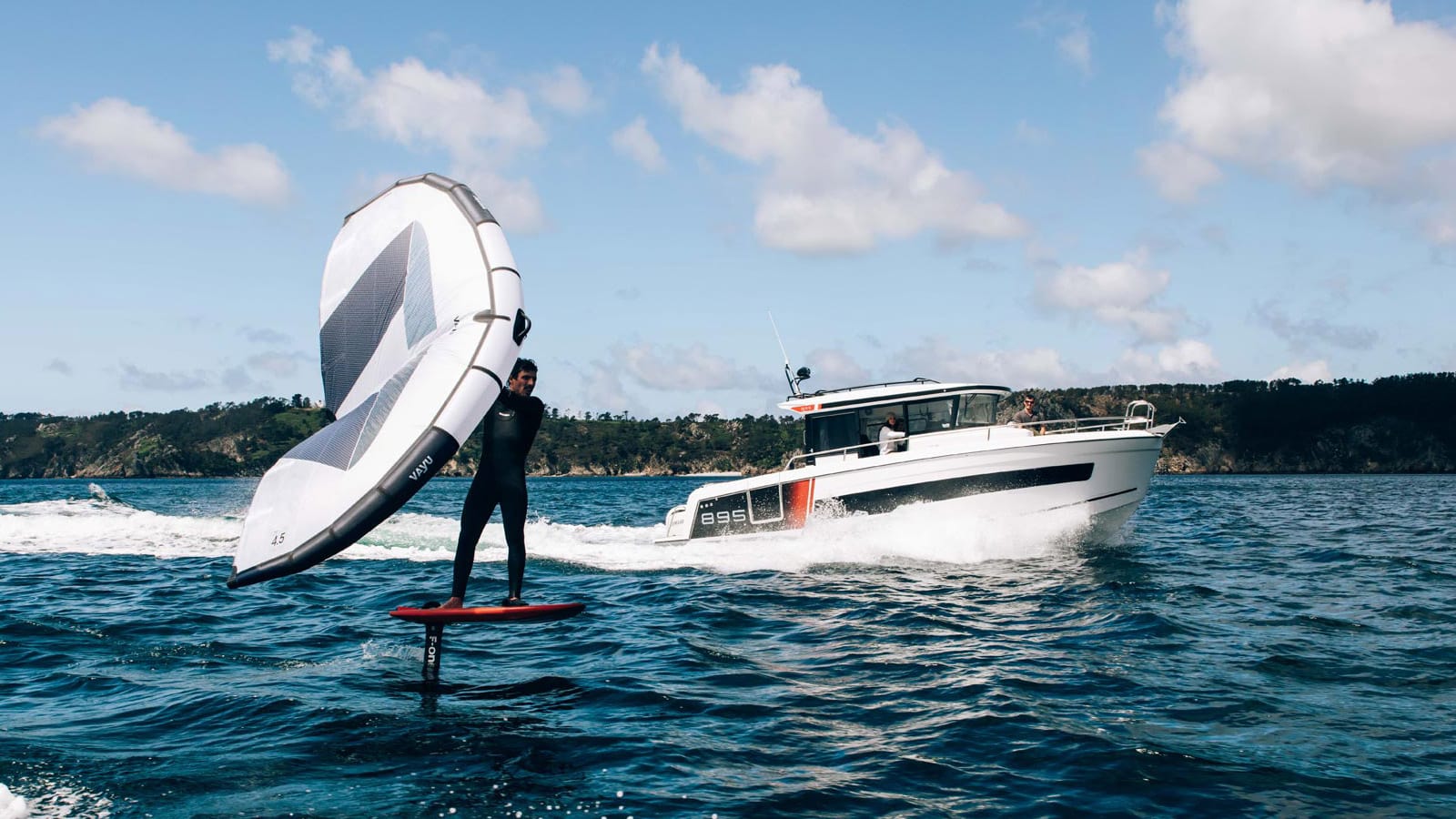
Jeanneau conquers new markets: all the latest additions from Cannes 2024
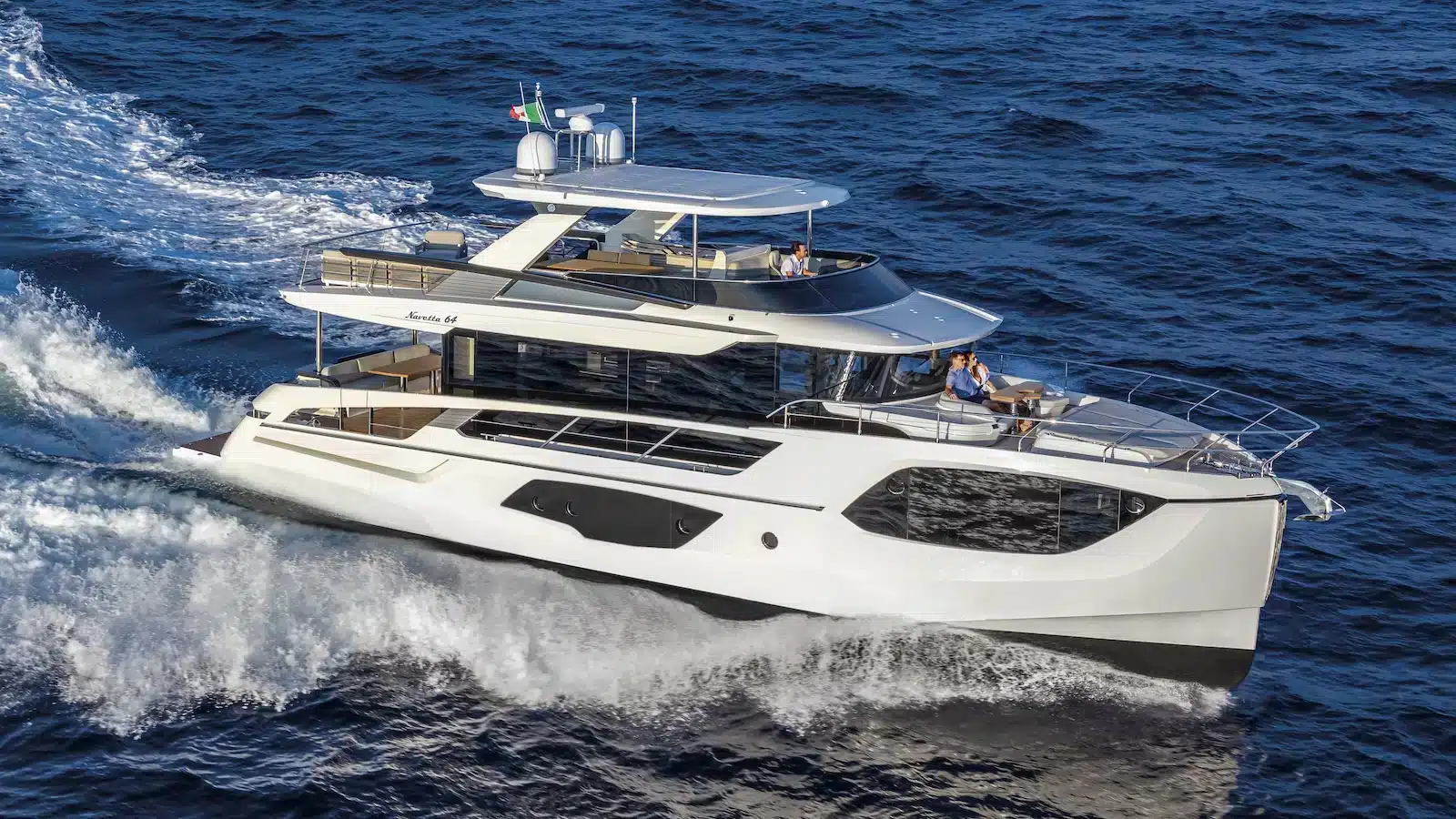
Absolute Yachts at Cannes with a contemporary and innovative collection

Innovative Sailing World Championship: English crew triumphs
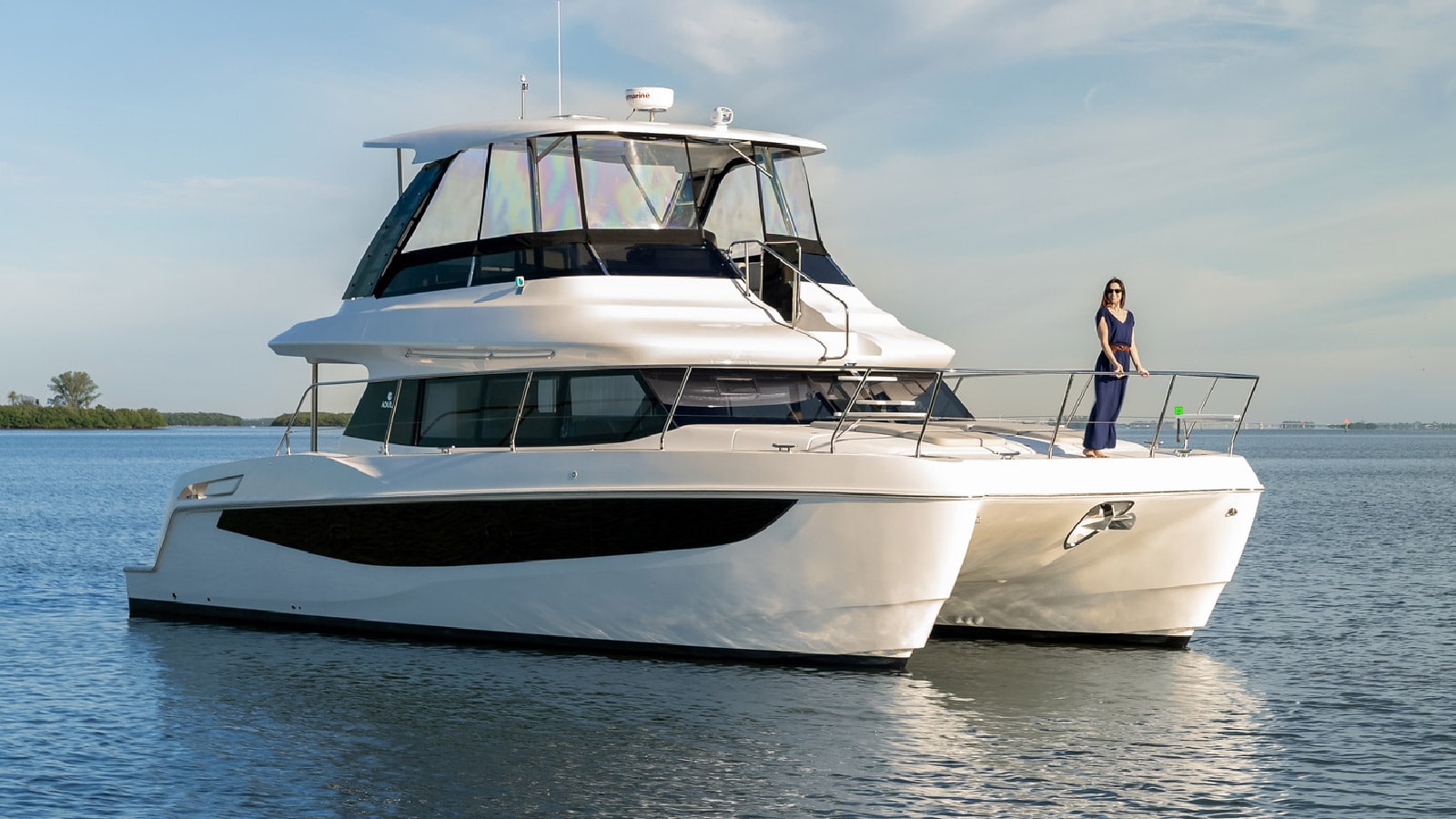
Aquila Power Catamarans conquering Cannes

© 2021 – THE INTERNATIONAL YACHTING MEDIA Designed by BLive Communication
ABOUT YACHTINGNEWS.COM
Yachting News is an interactive multimedia magazine dedicated to the world of boating.
The International Yachting Media is the worlds most widely read boating magazines network. Whit its portal It broadcast its original contents in five languages and in more than 200 countries developing 950,000 views a week. Our web portals are the main source of information for yacht and boat owners, the place where they can find anything about their boating passion.
THEINTERNATIONALYACHTINGMEDIA.COM | SUPERYACHTS.NEWS | YACHT DIGEST
VIRTUAL BOAT SHOW | TUTTTOBARCHE | TOUSLESBATEAUX | TODOSLOSBARCOS
BOATING NEWS FREE APP

To provide the best experiences, we and our partners use technologies like cookies to store and/or access device information. Consenting to these technologies will allow us and our partners to process personal data such as browsing behavior or unique IDs on this site and show (non-) personalized ads. Not consenting or withdrawing consent, may adversely affect certain features and functions.
Click below to consent to the above or make granular choices. Your choices will be applied to this site only. You can change your settings at any time, including withdrawing your consent, by using the toggles on the Cookie Policy, or by clicking on the manage consent button at the bottom of the screen.
Subscribe For Latest Updates
Sign up to receive the best of Yachting News, sea trials, boat review and world premieres .
The only ADVERTISING FREE newsletter
Below Deck Sailing Yacht Exes Daisy Kelliher and Gary King Have Explosive Reunion in Season 5 Trailer
Below deck sailing yacht 's daisy kelliher confronts "pr--k" gary king following their failed boatmance in e news' exclusive first look at season five. plus, meet the new yachties..
Below Deck Sailing Yacht 's new season will be anything but smooth sailing.
That's because returning costars Daisy Kelliher and Gary King are anything but friendly after their failed boatmance in E! News' exclusive first look at the Bravo series' fifth season.
Following Daisy, Gary and BDSY alum Colin MacRae 's messy love triangle , Daisy is still reeling from the complicated and dramatic fallout from last season.
"Going into this season, I got rid of some dead weight," the newly single Chief Stew says in the trailer. "The breakup did a number on me last year. I felt very broken. But now, I'm coming back in more focused, full of energy and I'm f--king good at my job. And I'm taking back the reigns."
Despite her initial confidence about returning to the Parsifal III , Daisy adds, "It's gonna be a s--t show."
Cut to the Ireland native yelling at Gary, "Guess what? We have a f--king job to do and I'm not f--king carrying this season on my own, you f--king pr--k!"
But luckily for Daisy, the preview teases her quickly moving on with new Deckhand Keith Allen , who tells Gary, "Daisy would make a very good wife. No?"
As for Gary's response, he bursts out laughing at the crewmember's declaration.
However, Daisy feels the same about Keith and tells him, "You're the kind of person I've never met before."
And when it comes to this season's charter guests, the yachties have too much of a good time with one group on shore.
After a night out, Captain Glenn Shephard warns the team, "You guys went out with some guests, I set some ground rules. Two drinks maximum. You knew the rules, you broke the f--king rules, and now you're here getting upset."
Check out the trailer above for a preview of all the drama to come. And keep reading to meet new yachties Chef Cloyce Martin , Chief Engineer Davide Morosi , Stews Diana Cruz and Danni Warren and Deckhand Emma Crouch .
Below Deck Sailing Yacht premieres Monday, Oct. 7, at 9 p.m. on Bravo. Episodes will be available to stream next day on Peacock.
Captain Glenn Shephard
Capt. Glenn and his expert crew set sail on Parsifal III to the luxury party capital of the world, Ibiza. While Ibiza is known for its sunny day parties and crystal-clear coast, it’s stormy waters ahead for the crew as they navigate blossoming boatmances, competitive co-workers and tense personal dynamics, all while trying to raise the bar every charter.
Chief Stew Daisy Kelliher
After a distracting love triangle last season that took her focus away from work, Daisy is ready to take the reins back in the interior department with a new sense of energy and determination. However, plans for a stress-free charter season are threatened when her stews question her leadership.
First Mate Gary King
On deck, Gary attempts to keep his team motivated as one crew member struggles to learn the ropes.
Chef Cloyce Martin
In the galley, Chef Cloyce charms the crew and guests but at only 22, he may be too inexperienced to meet the demands of the high-maintenance charter guests.
Deckhand Keith Allen
Stew Diana Cruz
Deckhand Emma Crouch
Stew Danni Warren
Chief Engineer Davide Morosi
(E!, Bravo ad Peacock are all part of the NBCUniversal family)

IMAGES
VIDEO
COMMENTS
Entering a marina berth with a following stream is only for those already adept at boat handling. It requires a parallel approach at a speed fast enough to maintain steerage but slow enough to dock safely. As a result, it's a manoeuvre with few, if any, bail-out options if your approach is not perfect. Often, the easier solution is to time ...
Imagine setting sail towards the horizon, feeling the wind in your hair and the sun on your face. Owning a boat opens up a world of adventure and freedom. But, when it's time to return to land, many boat owners face a daunting challenge - berthing their vessel safely.. Berthing, or docking, can be a nerve-wracking task for even experienced sailors.
a) Bow-in berth: In this technique, your boat is maneuvered into the berth facing forward, with its bow (front end) pointing towards the dock. b) Stern-in berth: Here, your boat is reversed into the berth so that its stern (rear end) faces the dock. This technique offers better control during departure. 3.
by Emma Sullivan | Jul 20, 2023 | Sailing Adventures. Boat berth refers to a designated space for mooring or docking a boat. It provides a secure location for boats to be anchored and can be found in marinas, ports, or designated areas along water bodies. The availability of boat berths may vary depending on the size and type of the boat, as ...
As you enter the berth a crewmember standing at the widest point of the boat needs to attach the windward sternline or midships line, depending on your preference. If double-handed, they can then ...
But, if you're sailing short-handed, using a midships spring is a useful tool. A short spring led from a midships cleat will help secure your boat in its berth. Additionally, when leaving a berth, this spring enables you to cast off all other lines first. This leaves just the spring which can be easily slipped if necessary. 6.
• When berthing with a bow thruster, a large ship may ... • Avoid high forward speed when: - working with tugs - using a bow thruster - under-keel clearance is small - sailing in a narrow channel or when close to other ships. • Test astern movement and wait until the ship moves ... fast motor yacht will have a B/T ratio of about 5.75.
Continuing his series of sailing shorthanded, Simon Phillips looks at berthing, anchoring and picking up a buoy. Berthing. Coming alongside is the source of most damaged dignity in the marina and has potential for some very expensive repairs. Planning and preparation will ensure that it will go as smoothly as possible. 1. Call ahead
Step 5: Prepare the fenders at a height and in a position on the boat suitable to the wharf or pontoon you are approaching. Step 6: Prepare any ropes you may need to secure the vessel once berthed. You will require a stern line and a bow line to secure the boat to the wharf and at least one springer line to prevent fore and aft movement and to ...
Berthing in Dubai is a term derived from berth which means a.) (noun) an allocated space within a dock where a vessel can be moored, and b.) (verb) the act of mooring a vessel on its allocated space in a dock. Berthing is often used to describe and show the different types of mooring that occur. Berthing, especially yacht berthing, describes ...
A berth or bunk is a sleeping area or bed, typically bunk beds on a ship. 2. The Purposes of the Berth of a Ship. Sleeping on a sailboat isn't easy. Instead of trying to sleep while sitting, sailor and boating enthusiasts use berths, bunks, or sleeping quarters to get some peaceful and comfortable shut-eyes.
By docking your boat, you practically sail until you reach a fixed structure that allows you to get out on the land. This structure is called a dock and your boat is fastened to it. Berthing means placing your vessel in the fixed location known as a berth. To make it easier to understand, imagine that the berth is basically your boat's ...
Factors to Consider When Choosing Between Dry and Wet Berths. Frequency of use. For Mina Rashid boaters who enjoy frequent, spontaneous outings, a wet berth offers unmatched convenience. However, if you use your boat less frequently, a dry berth might be more cost-effective as it minimises hull wear and tear during periods of inactivity.
Berthing a vessel is not just about parking a boat; it requires skill, precision, and a deep understanding of the surrounding elements. Navigating safely while berthing or docking can be challenging for even seasoned sailors. In this comprehensive guide, we will walk you through the crucial steps involved in berthing and docking your vessel safely.
Once clear of the box, bring the stern into the wind. The bow will blow down and help speed up your rate of turn. 1. Slip the leeward bow and stern lines first. In strong crosswinds, a ball fender on the leeward bow offers protection to a leeward boat, and a midships spring (see Top Tip, below) works well. 2.
For shorthanded sailing, a "wet berth" is a vital asset to boathandling and safety. A wet berth is a secure rest area protected from inclement weather where the skipper or watch stander can rest (often in foulies), immediately available to lookout, steer, trim, or perform other boat handling responsibilities.
Here are the four big learning I gained during this 6-day sailing school-cruise on an X-442 yacht: The best marina berthing maneuver ever, casting off stress-free, a very quick Figure-8 alternative and last not least the most simplistic last minute maneuver. The best thing: It is possible to do all these maneuvers single-handed.
1. Sleeping Berth. While usually referring to the sleeping area on a vessel, such as a bed or a bunk, it may also mean any space allotted for people staying on a vessel. The berth on a boat can be one of a few different types, and these relate to their location on a boat. Let's look at four common types.
The Importance of Comfortable and Functional Berths on a Boat. When it comes to sailing the high seas, there are a few essential elements that can make or break the experience. While many might focus on the navigation equipment, the safety gear, or even the aesthetics of a boat, one often overlooked factor is the berths - those cozy sleeping ...
Choosing a berth is a topical thought. Never as now, in the light of the recent extraordinary weather events, the issue of boat safety at ports, once taken for granted, has become a primary concern in the mind of boat owners, overshadowing other aspects such as comfort, costs and services. The question therefore is: which berths are safer and ...
Below Deck Sailing Yacht's Daisy Kelliher confronts "pr--k" Gary King following their failed boatmance in E! News' exclusive first look at season five. Plus, meet the new yachties.
Key art for 'Below Deck: Sailing Yacht' season 5. The series will air on BRAVO on Monday, October 7. Bravo/Bravo. Suarez detailed her alleged traumatic experience with King in an email to Rolling ...
A Teralani Sunset Sail boat ran aground near Whalers Village on Maui Tuesday night. Four people were hospitalized after the incident, which occurred around 7 p.m.
Riviera loaded seven new motor yachts onto the container ship Majestic at the Port of Brisbane last Thursday bound for Florida, including its latest creation, the 6800 Sport Yacht Platinum Edition.